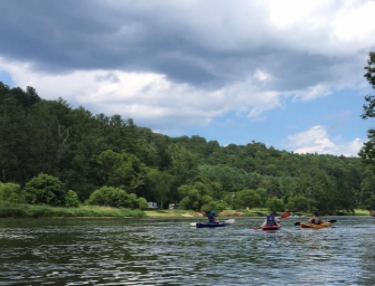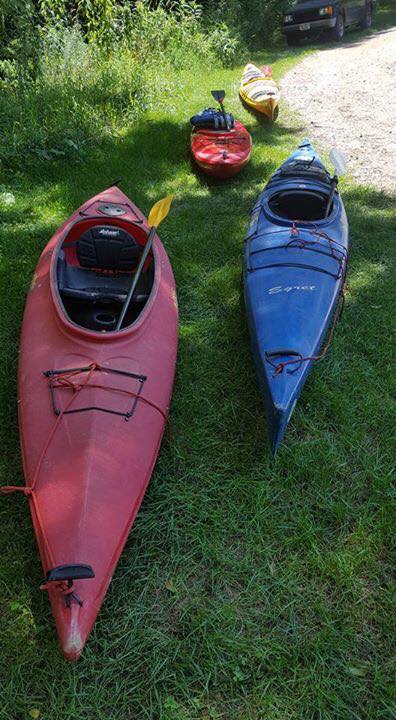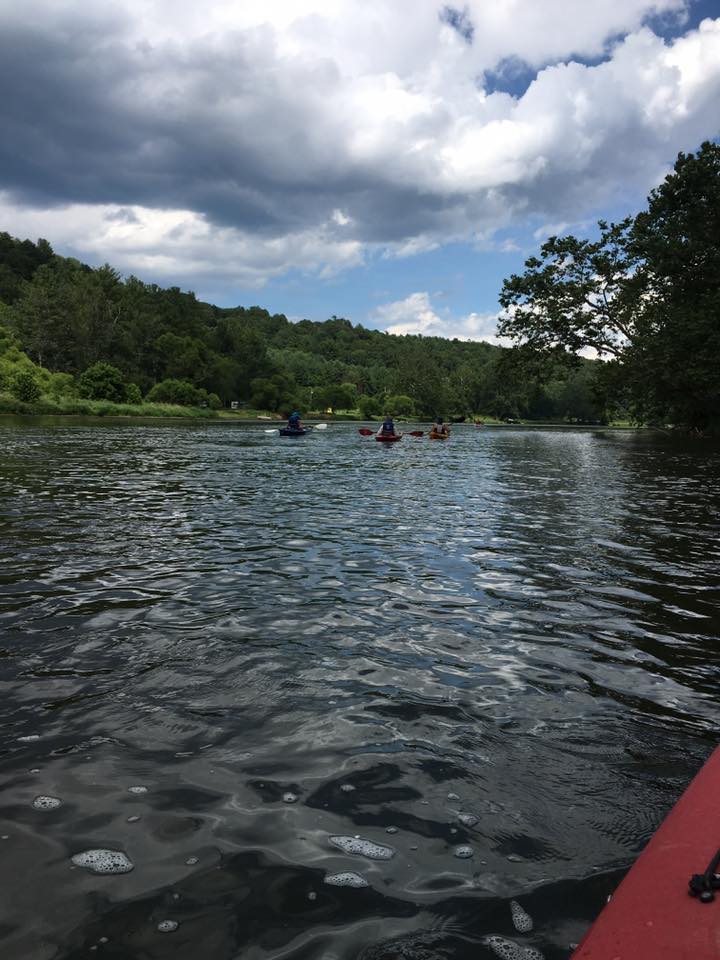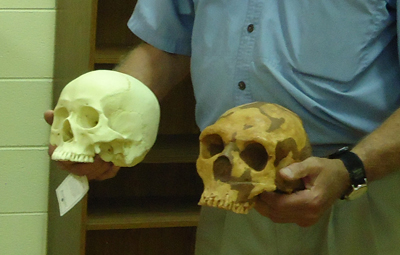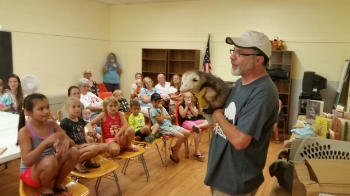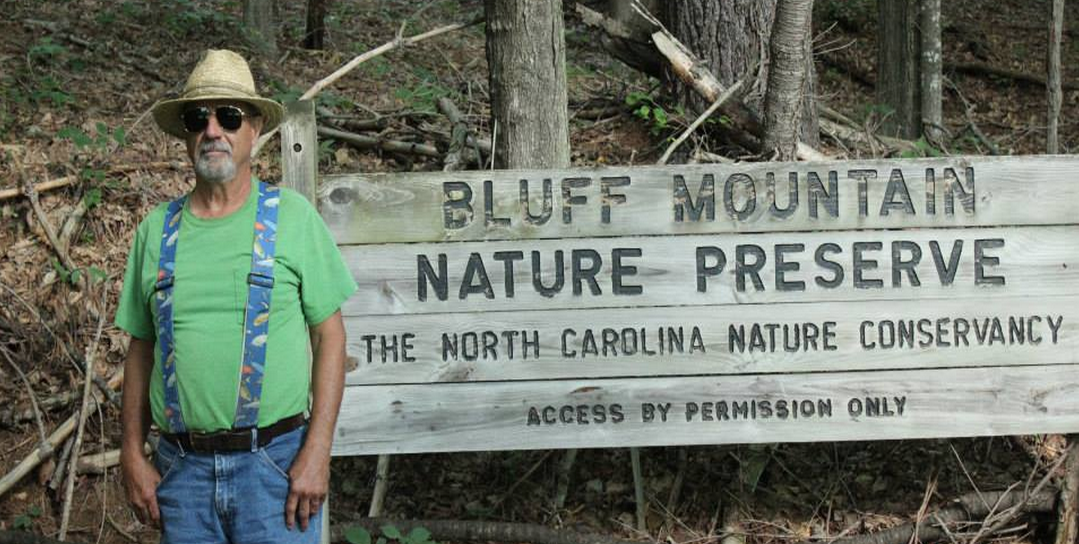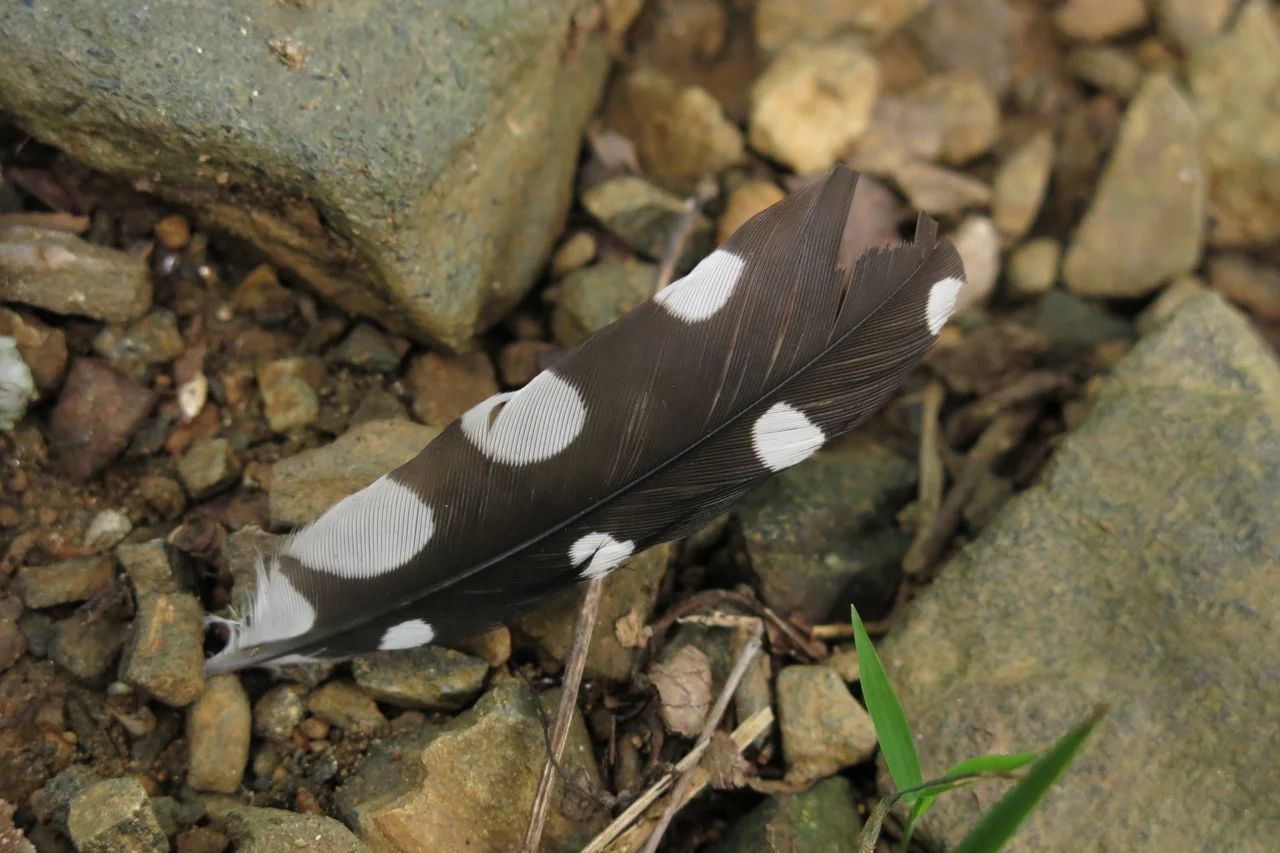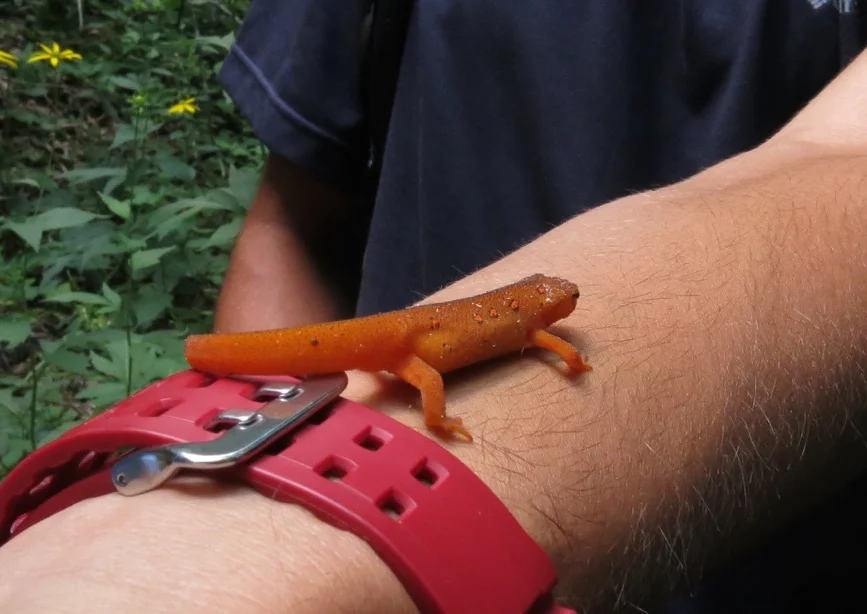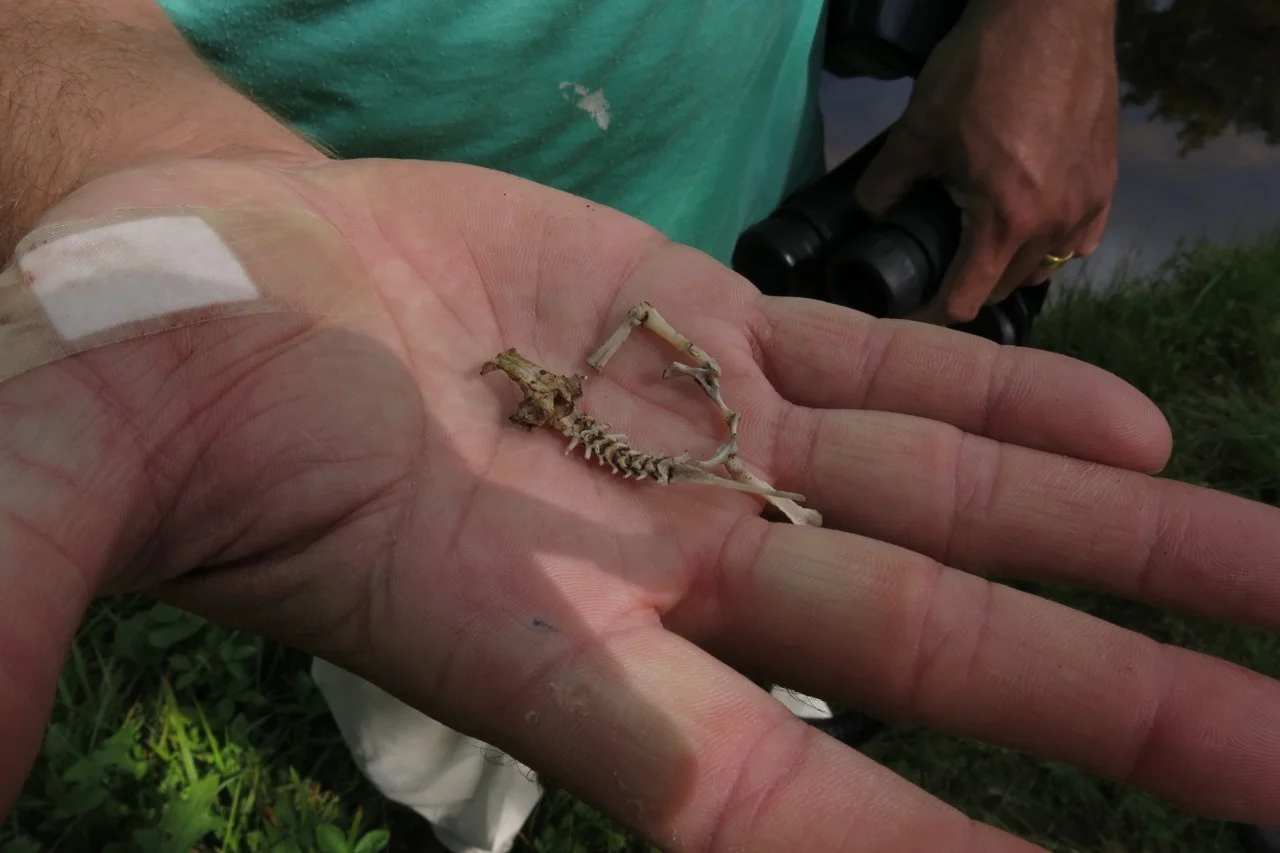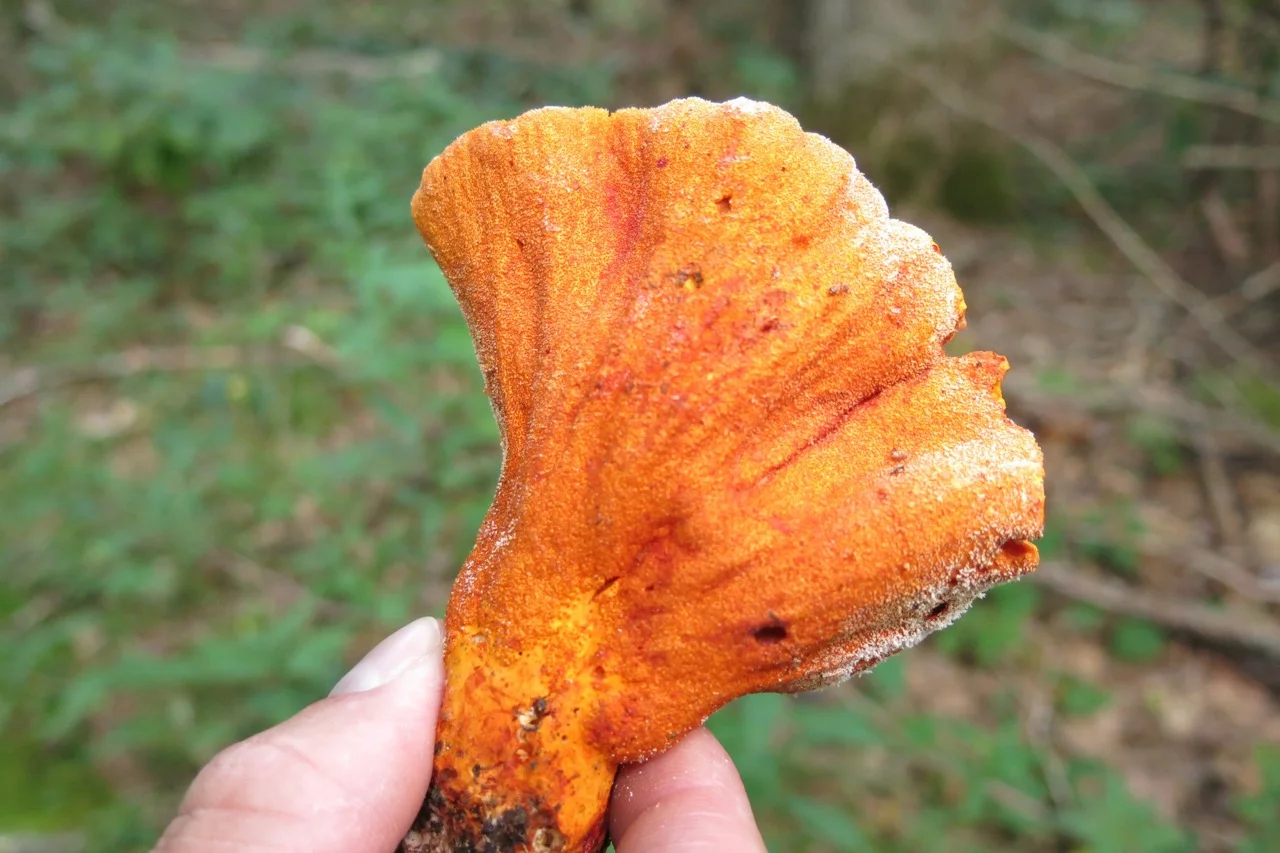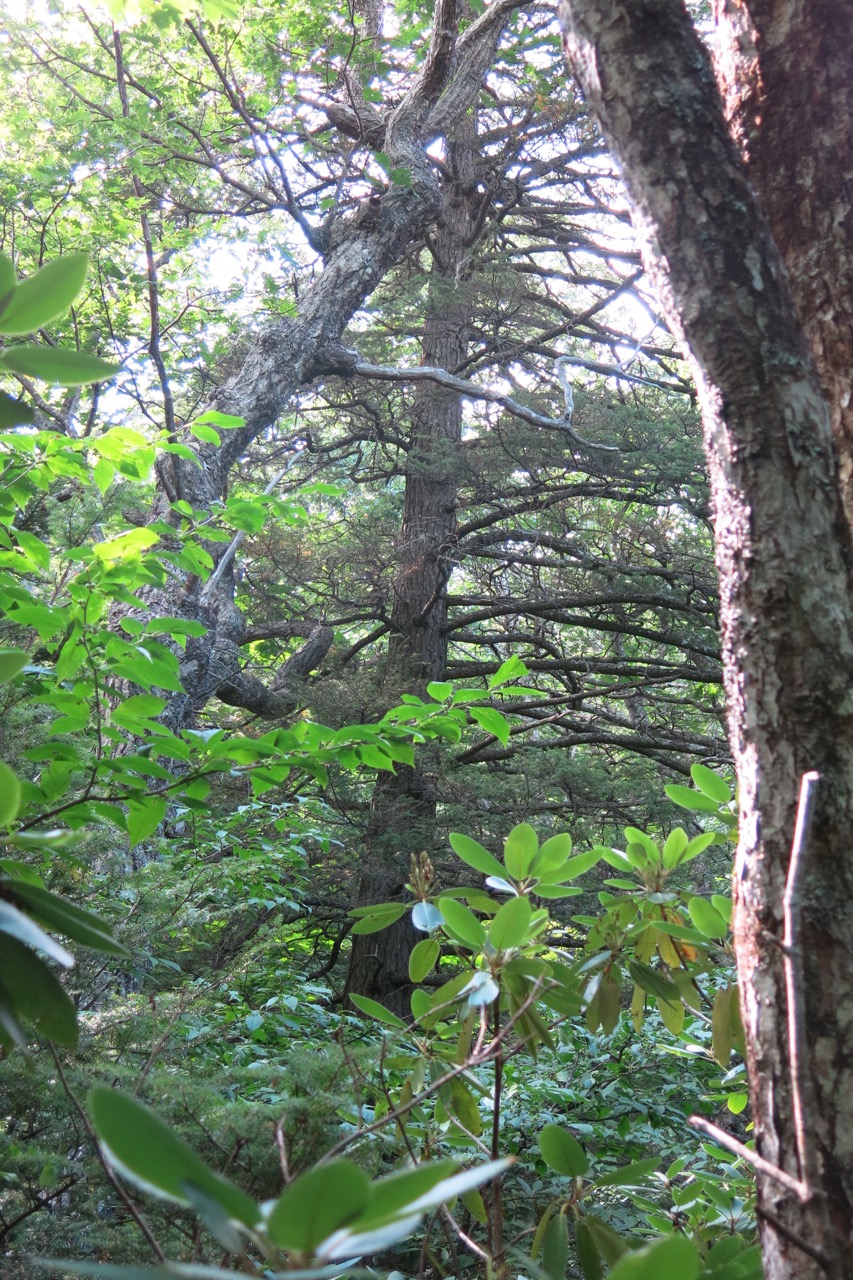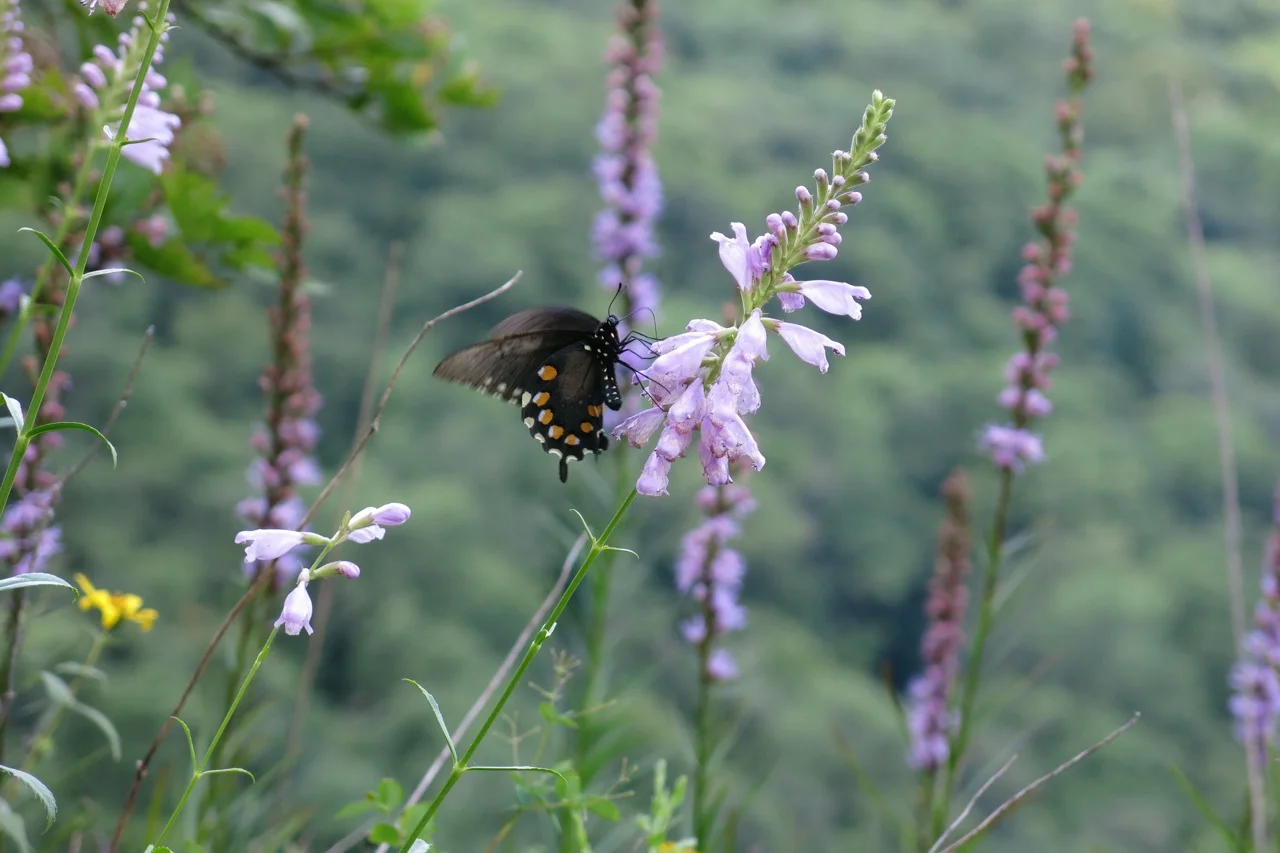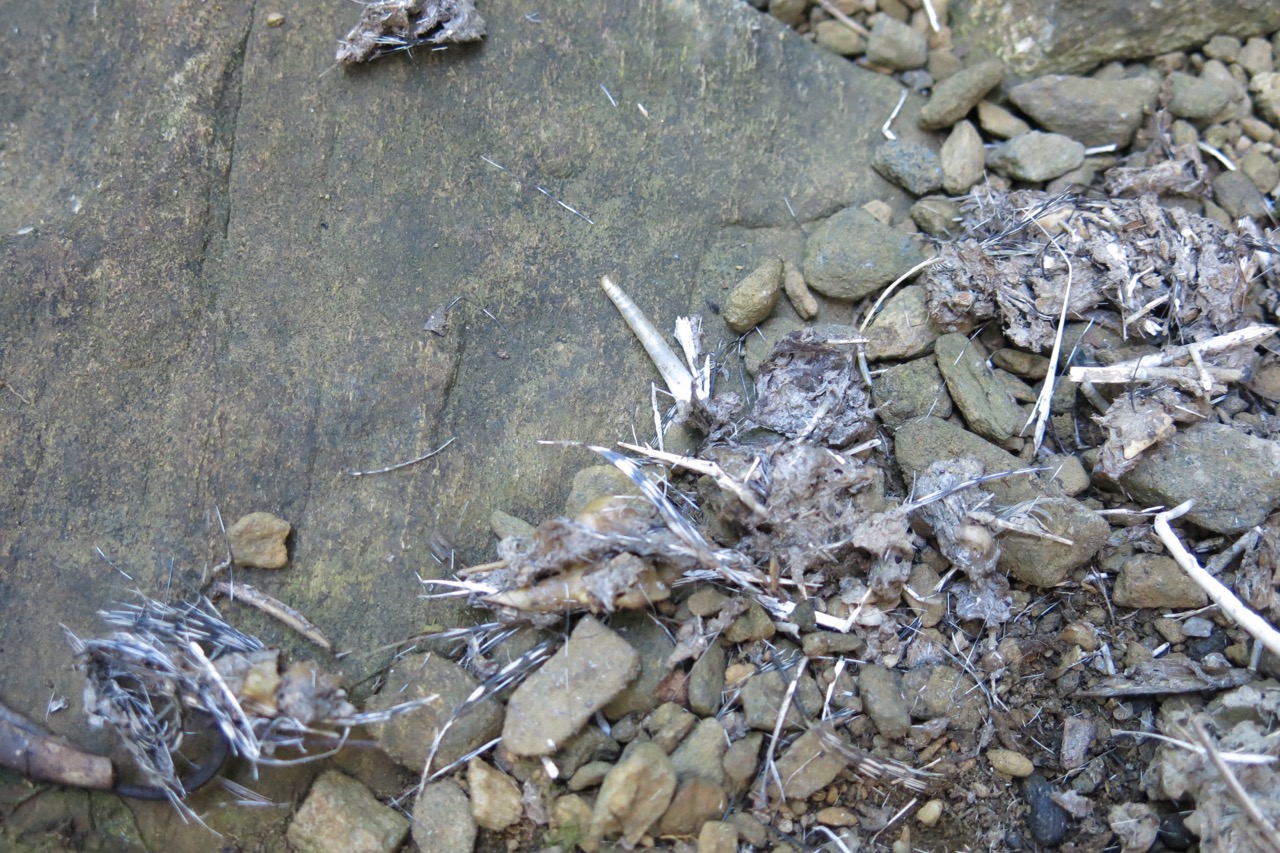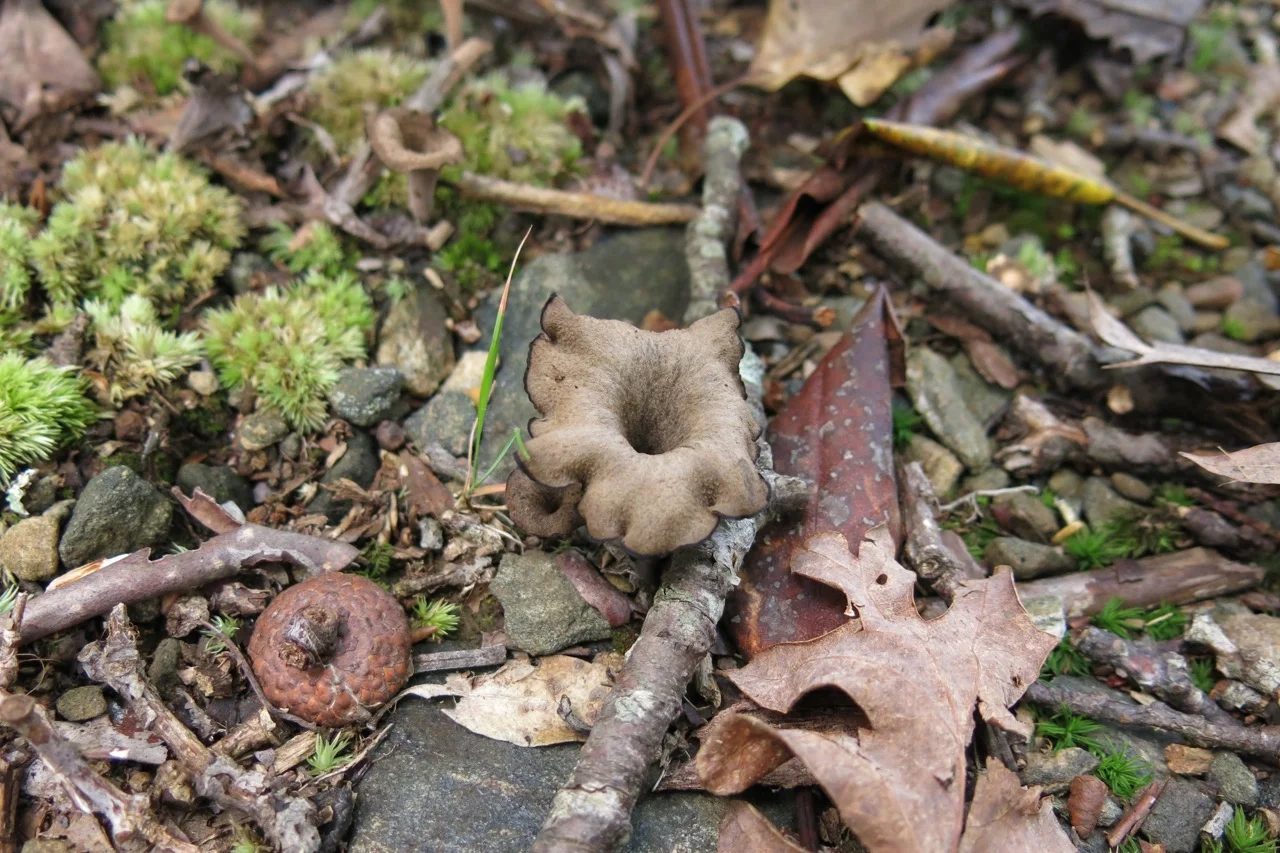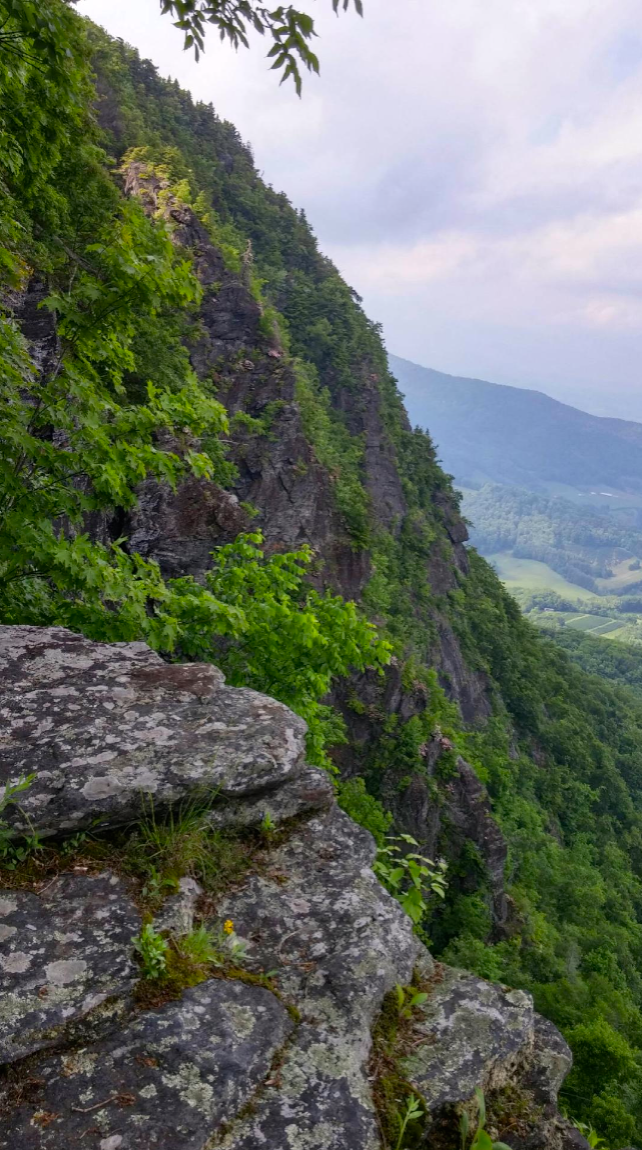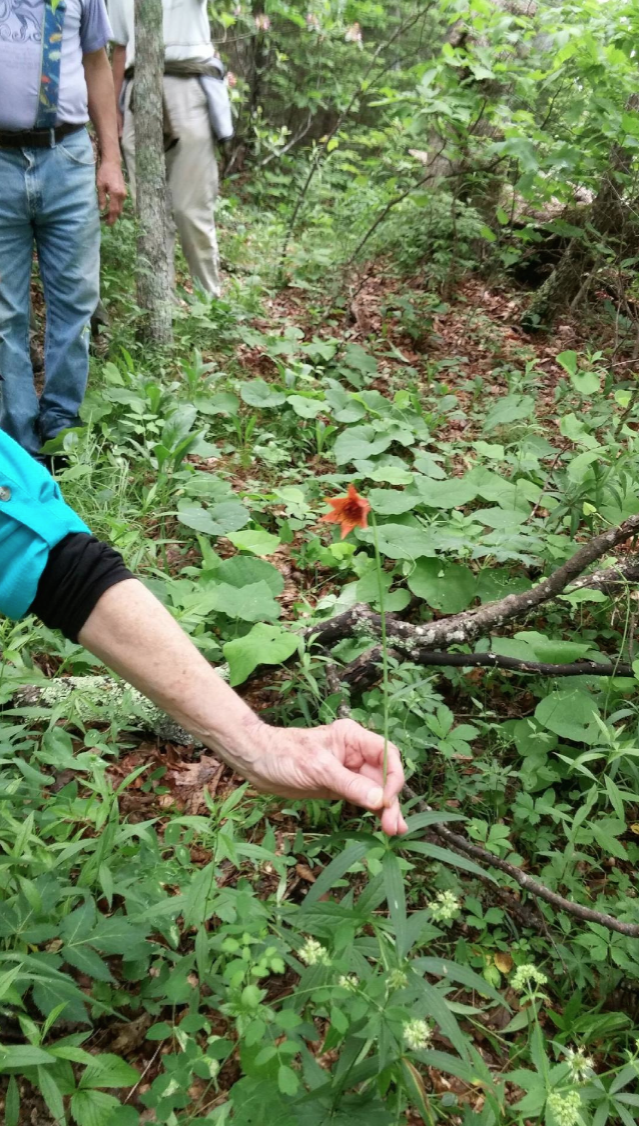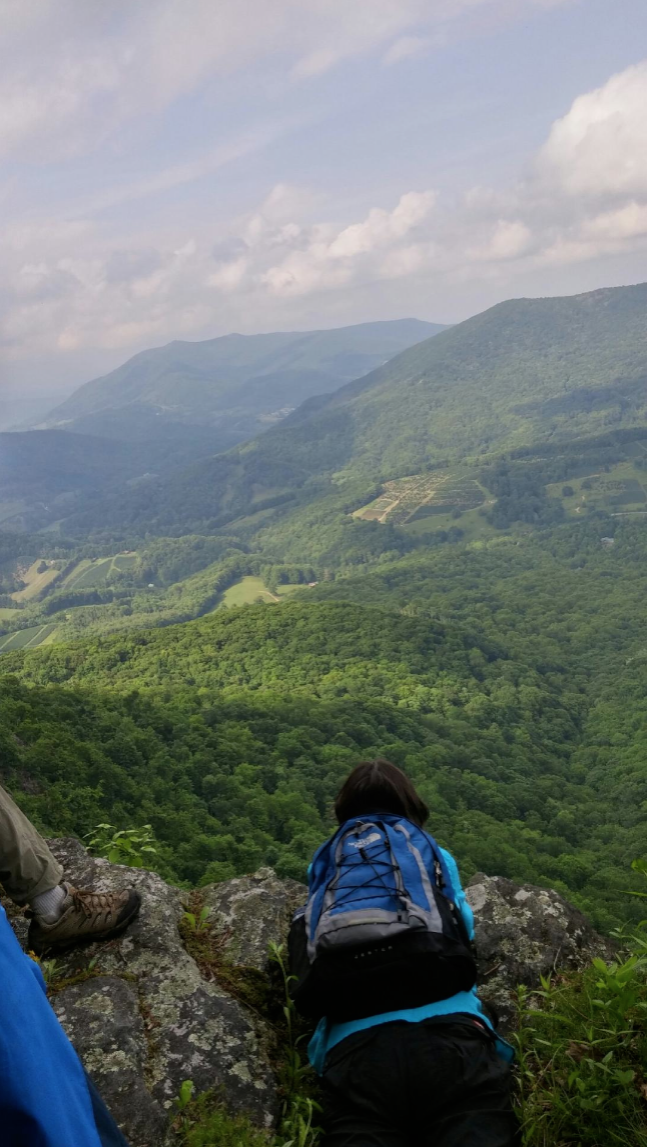
Blue Ridge Explorers Club on the New
Stormy weather turned the July Blue Ridge Explorers Club "Full Moon Float" into a "Sunny Day Float" on a different section of river.
Stormy weather turned the July Blue Ridge Explorers Club "Full Moon Float" into a "Sunny Day Float" on a different section of river.
1 great egret, numerous Canada geese, dragonflies & damselflies hitching rides on the boats, big rocks, glorious weather and great folks.
How Mammals Make a Living
Dr. William Hylander, Duke University Professor of Anthropology Emeritus, dropped by the Grayson County Library on Friday July 8th to share his 'How Mammals Make a Living' program.
Dr. William Hylander, Duke University Professor of Anthropology Emeritus, dropped by the Grayson County Library on Friday July 8th to share his 'How Mammals Make a Living' program. With a stunning array of skulls complete with jaw bones, Bill showed how teeth define what an animal eats, how it lives and defends itself.
Canines are the 'fangs' or ripping tools, incisors are the biting tools, and molars allow chewing. Depending on whether a mammal is carnivorous, omnivorous or herbivorous, tooth and jaw details and arrangements give clues to that animal's life history.
Mammals Program @ the Grayson County Library
Darin Handy recently joined BRDC for an event held at the Grayson County Library. His amazing mammals program captivated an audience of 50 people from infant to 80 and over.
Darin Handy recently joined BRDC for an event held at the Grayson County Library.
His amazing mammals program captivated an audience of 50 people from infant to 80 and over. With a mix of skins, magic tricks and unbridled enthusiasm, he held the crowd's attention, while emphasizing the basic principles of conservation and love of wild critters.
And we can't forget Maggie, the one eyed ambassador of wild animal rehabilitation for educational purposes...
Grayson 1st Graders Visit Matthews Farm
On May 13th, BRDC participated in Matthews Living History Farm Museum's Farm Day for Grayson County 1st graders.
On May 13th, BRDC participated in Matthews Living History Farm Museum's Farm Day for Grayson County 1st graders.
Seven learning stations were available for the students to learn about how people lived in 1900: Farming tools, farm animals and their uses, plants and their uses, fibers from plants and animals, a spring house as refrigeration, and insects and their benefits (led by BRDC staff). The students participated in a variety of hands-on activities including searching for bugs, planting in the garden, and dancing to live music on the front porch.
BRDC's Bug Program teaches that not all bugs, insects, and spiders are pests. We discuss the benefits of pollination and predation of good bugs on bad bugs. Finally, we talk about how important bugs are to the food chain. With nets in hand, the kids spread out across the farm's lower field to collect and examine the tiny critters. Some are placed in viewing boxes so they can take a closer look. If screams are any indication of their excitement, the kids had a great time.
Explorers Club Spring Wildflower Walk
Carol Broderson led a group of 17 explorers on an early spring, wildflower walk along the New River Trail last Saturday.
Carol Broderson led a group of 17 explorers on an early spring, wildflower walk along the New River Trail last Saturday. Carol is a Mt. Rogers Appalachian Trail Club volunteer, and also works with the Trails to Every Classroom program.
The wooded slopes adjacent to the trail were carpeted with spring wildflowers including Blood Root, Red Trillium and Early Saxifrage.
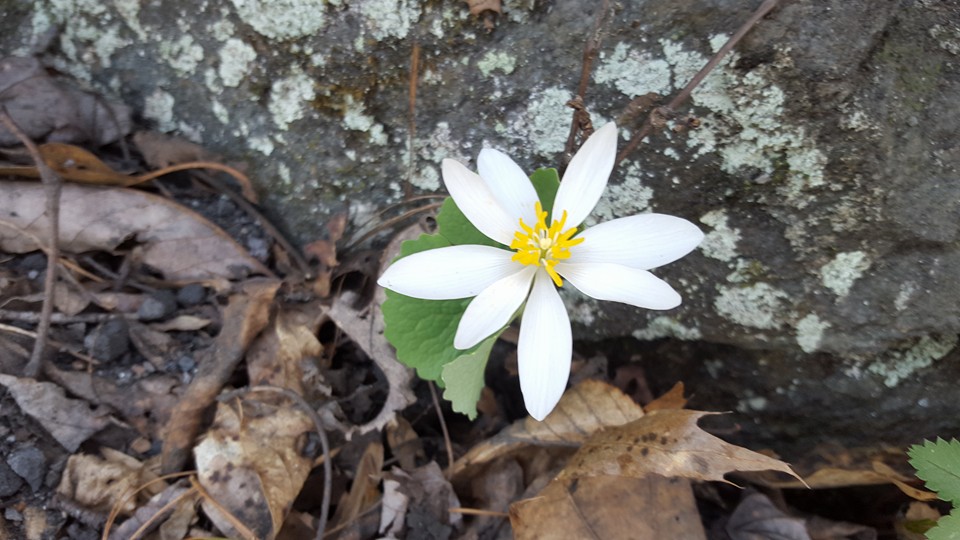
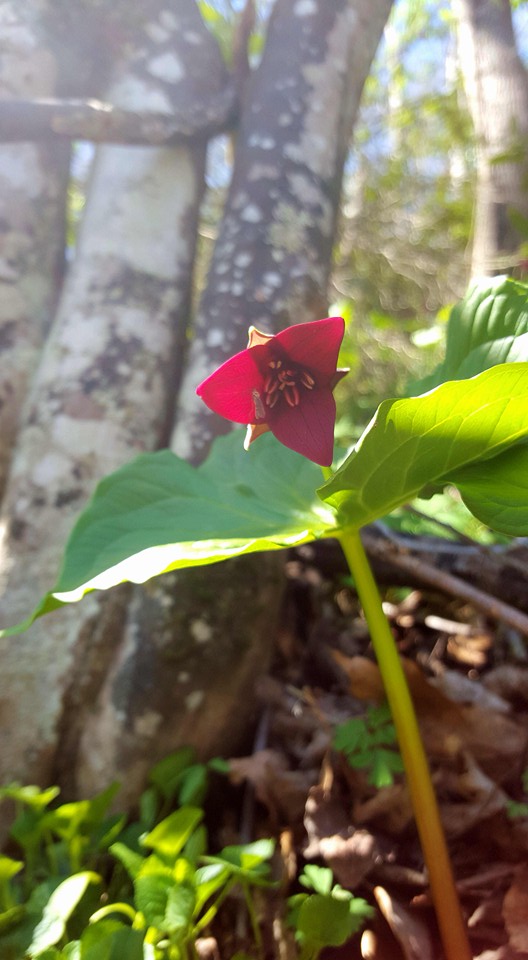
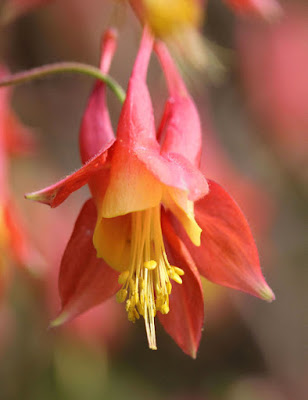

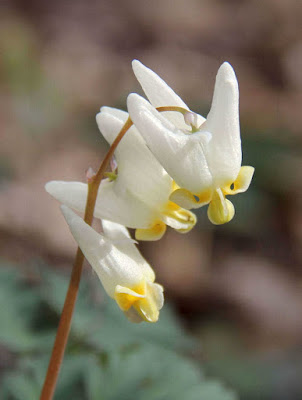
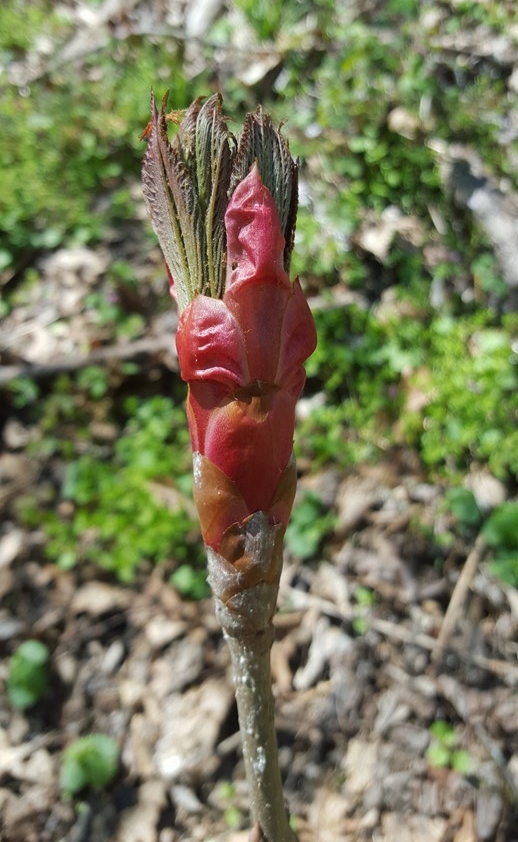
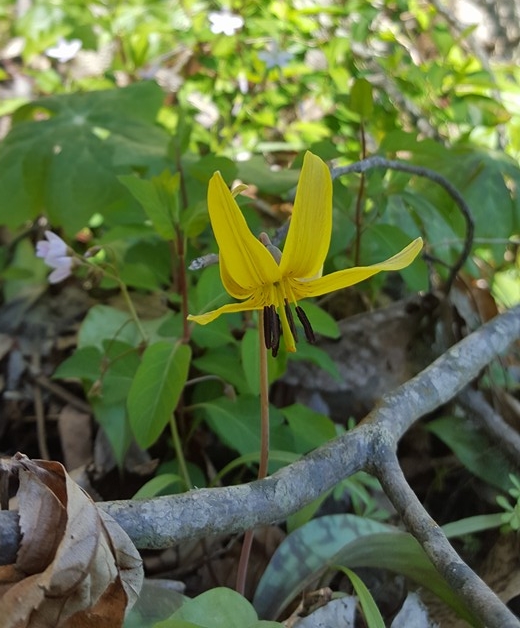

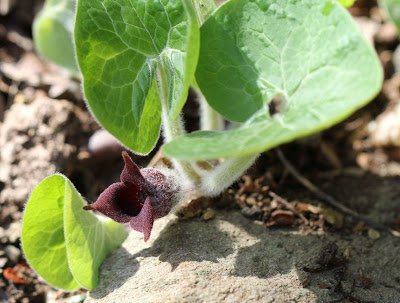
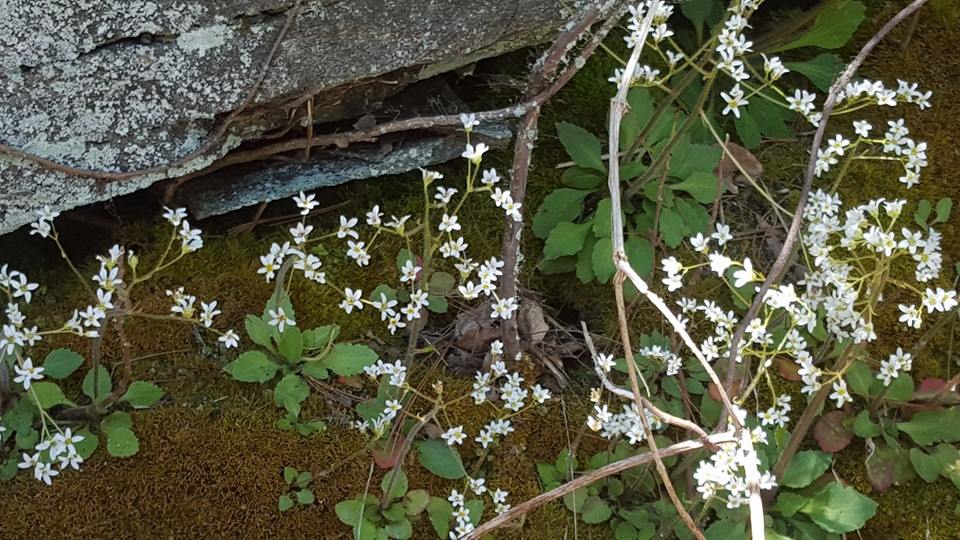
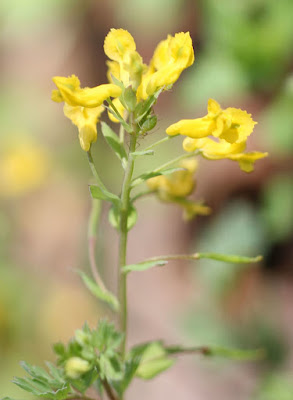
Partial Species List:
Bloodroot Sanguinaria canadensis
Blue Cohosh Caulophyllum thalictroides
Bluets Houstonia caerulea
Columbine Aquilegia canadensis
Common Blue Violet Viola sororia
Cutleaf Toothwort Cardamine concatenata (formerly Dentaria laciniata)
Dutchman's breeches Dicentra cucullaria
Early Saxifrage Saxifraga virginiensis (saxigfrage means rock breaker)
Flowering Dogwood Cornus florida
Golden Ragwort Packera aurea
Mayapple Podophyllum peltatum
Recurved Buttercup Ranunculus recurvatus
Eastern Redbud Cercis canadensis
Red Trillium Trillium erectum
Spring Beauty Claytonia virginica
Star Chickweed Stellaria pubera
Trout Lily Erythronium americanum
Wild Ginger Asarum canadense
Yellow Fumewort Corydalis flavula
Explorers Club Full Moon Hike
Any full moon hike is special but add the second highest peak in VA, a 250+ acre grassy bald and a gnarled beech forest and it becomes truly spectacular!
Any full moon hike is special but add the second highest peak in VA, a 250+ acre grassy bald and a gnarled beech forest and it becomes truly spectacular!
The Blue Ridge Explorers Club March Full Moon Hike, exploring Whitetop by moonlight, was so much fun that the group decided it would be the first of many full moon hikes this year.
The Blue Ridge Explorers Club is an informal group that meets monthly, on the first Tuesday at Creek Bottom Brews in Galax at 6:00pm. The Explorers host an exploration once a month, with the opportunity for many ad hoc explorations as decided by the members.
Fall at Bluff Mountain
On Sunday, October 11, the Blue Ridge Discovery Center sponsored a tour hike to the Nature Conservancy's Bluff Mountain Nature Preserve on a perfect fall day. Temperature in the low 60's, light breeze under a cerulean sky, the forest at near peak fall coloration, the group of eleven hikers strolled through some of the rarest ecologies in the Southern Appalachian Mountains.
On Sunday, October 11, the Blue Ridge Discovery Center sponsored a tour hike to the Nature Conservancy's Bluff Mountain Nature Preserve on a perfect fall day. Temperature in the low 60's, light breeze under a cerulean sky, the forest at near peak fall coloration, the group of eleven hikers strolled through some of the rarest ecologies in the Southern Appalachian Mountains.
Above 4500 feet it appeared there had been a frost already and most of the herbaceous flora was burned and wilted. Then red, sugar and striped maples were in their fall glory. The mountain holly leaves were chartreuse and the females were spangled with brilliant red berries that shown like gems in the afternoon light. Flowers were few and far between, a smattering of closed gentian along the trail and in the fen, and tiny polygala at Perkin's Rock and the mesic glade. There was teaberry with full red ripe berries in the glade as well. A lone raven checked us out at Perkin's Rock as it soared on up the ridge towards the summit of the preserve, Cowface, where the elevation reaches 5,100 feet.
The group went off trail to visit a healthy 60' tall American Chestnut. The ground underneath the tree was littered with spiky hulls of the chestnuts but no nuts, the squirrels, grouse and deer had beat us to them.
At the vertigo bench, the dead oak that resembles a Can Can Dancer at full kick inspired a spontaneous Can Can line from four of the women hikers. They preformed admirably in spite of the slope and wet rubbly footing.
There continues to be damage from the hemlock adelgid around the Bluff, but continuing up the trail to the mesic glade the trees appear to get healthier and arriving in the glade the hemlock trees are specimens of health. An observation: where the trees are clumped in groves they are less healthy than where they are singular and spread apart.
A more pleasant stroll with good company through one of natures wonderlands sponsered by BRDC is hard to imagine!
Blue Ridge Discovery Center’s Fall Mushroom Walk
Twelve curious hikers joined Ken Crouse for his second annual BRDC mushroom walk on Saturday, September 19th. We met at Cox’s Chapel Low Water Bridge at 10am for a brief introductory show-and- tell prior to carpooling to a location across the river and into the woods.
Twelve curious hikers joined Ken Crouse for his second annual BRDC mushroom walk on Saturday, September 19th. We met at Cox’s Chapel Low Water Bridge at 10am for a brief introductory show-and- tell prior to carpooling to a location across the river and into the woods.
It was a ‘beautiful’ morning, crisp and clear, but also very dry following a week of bright, sunny days and low humidity...not the best of conditions for a mushroom foray. However, cool nights and mornings also trigger the fruiting of many fungi, so we had at least one thing in our favor.
Ken took us into damp areas, which proved to be productive enough to keep us busy identifying and comparing a wide variety of mushroom species. It is the purpose of most mushroom hunters to harvest for the kitchen table. Ken focused on offering descriptions of what to look for in great detail, how to sort through similar looking species from safe to deadly. The general morphology of a mushroom is an indicator, but the base of the stem and ‘root’ structure, careful inspection of the underside of the cap, and spore prints all add up to the level of confirmation needed to be certain of identification. Other clues include gill structure and attachment, smell, bruising color, and habitat. In fact, Ken said he usually employs seven systematic taxonomic features to assure a firm ID, and has not once in his long mushroom hunting life experienced any gastronomical discomfort from eating fungi. There are several spore dispersal systems besides gills, and serve to link specimens to family...such as the boletes which have fleshy tubes or pores, or the tooth fungi in the Hydnaceae family, puffballs which form spores inside, and club and coral fungi, which disperse spores from a fertile outer surface.
After collecting a number of specimens, we drove to a local picnic area where, and while taking lunch, Ken spread out field guides and our collection for a more thorough discussion on identification.
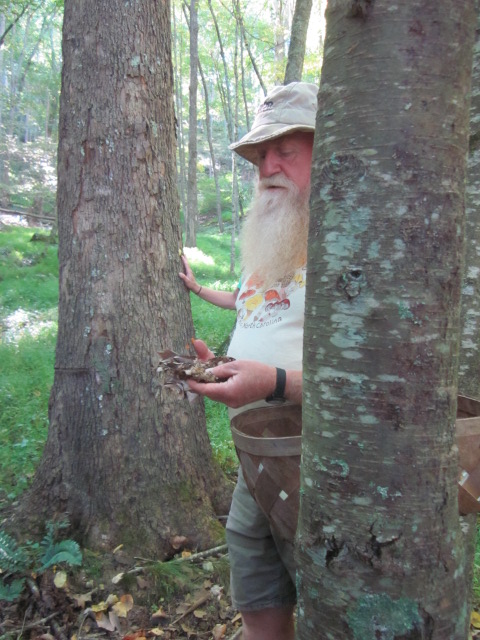


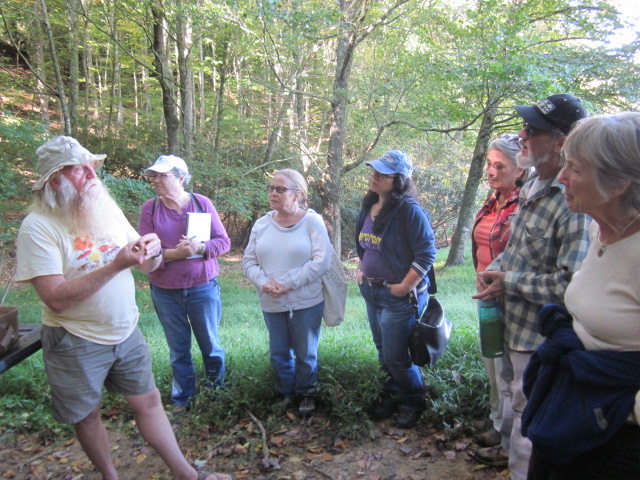
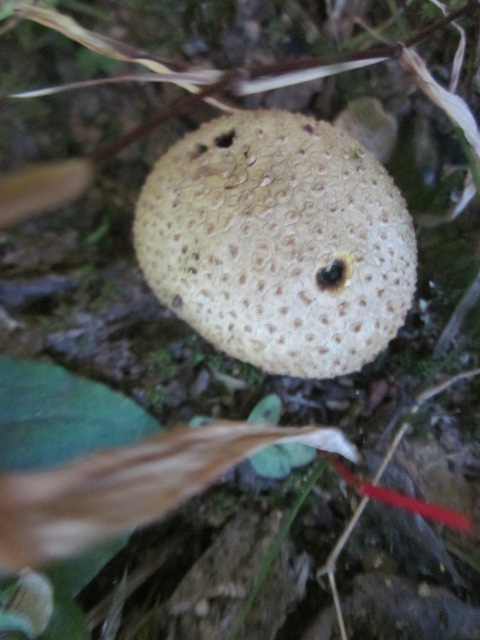
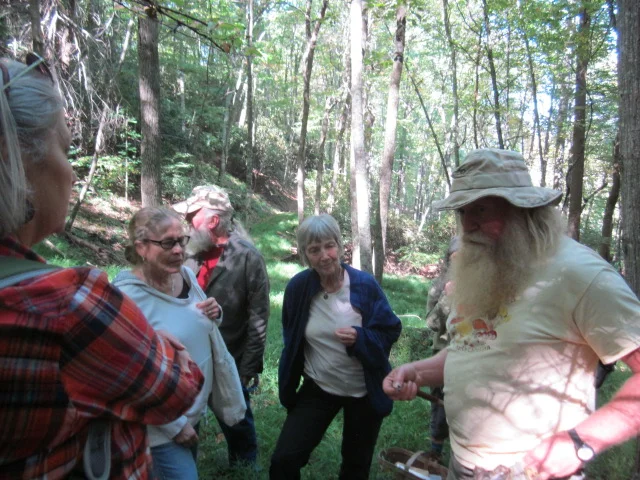
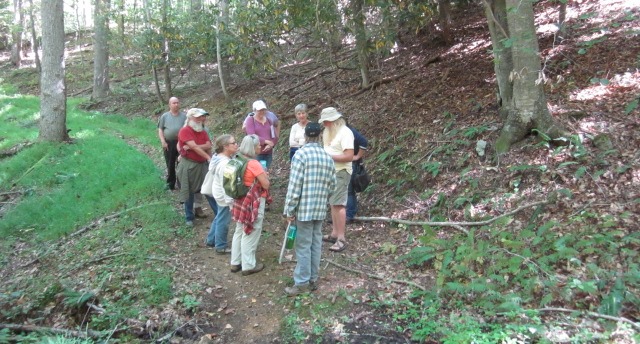
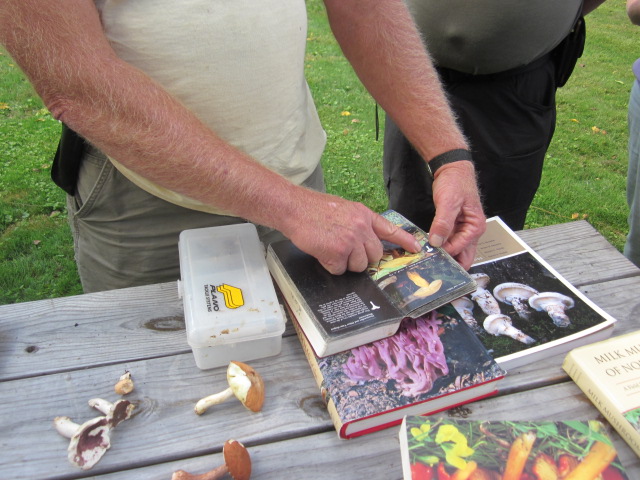
Following is a full species list from our day in the woods:
BRDC 9/19/15 Mushroom Walk, River Ridge Farm
Austroboletus gracilis – Graceful Bolete
Tylopilus plumboviolaceous – Lilac-brown Bolete
Suillus granulatus – Granular-stalked Bolete
Polyporus badius – Black-footed Polypore
Stereum ostrya – False Turkey Tail
Stereum complicatum – Bracket Mushroom
Trametes versicolor – Turkey Tail
Oxyporous populinus – White Polypore
Tyromeces chioneus – Cheese Polypore
Phellinus rimosus – Cracked Cap Polypore
Daldinia concentrica – Carbon Ball
Chlorocibora aeruginescens – Green-wood Stain
Lycoperdon perlatum – Gem-studded Puffball
Lycoperdon pyriforme – Pear-shaped Puffball
Schleroderma citrinum – Poison Pigskin Puffball
Scuttelaria scuttelina – Eyelash Cup
Hygrophorous praetensis – Waxy Cap
Clitocybe dilitata – White Clitocybe
Russula variata – Variable Russula
Marasmius sicca – Orange Pinwheel
Marasmius rotula – White Pinwheel
Crepidotus mollis – Jelly Crepe
Mycena pura –yellow Mycena
Mycena luteopallens – Walnut Mycena
Panellus stipticus – Luminescent Panellus
Collybia confluens – Tufted Collybia
Ramaria conjunctipes – Violet Coral
Usnea sp. – Tree Beard Lichen (Medicinal)
For a brief review of fungi see: http://eol.org/pages/5559/overview
Scott Jackson-Ricketts
Ken Crouse
Fun was had by all!
On Saturday, August 15th Blue Ridge Discovery Center got together for a day of exploration capped off by a potluck party!
On Saturday, August 15th Blue Ridge Discovery Center got together for a day of exploration capped off by a potluck party! We started the day early in Grayson Highlands State Park, hiking over Wilburn Ridge and crossing into Sullivan Swamp. Eight sturdy hikers and guide Devin Floyd made their way through the thickets looking at the plants, butterflies and birds of one of the rarest habitats in the region: a Southern Appalachian Shrub Bog.
Later in the afternoon we kicked off the festivities on site with a butterfly walk along an ironweed and goldenrod meadow seeing common buckeyes, eastern-tiger swallowtails, monarchs, meadow fritillaries, great-spangled fritillaries and sulphurs. Thunderclouds appeared rapidly overhead and we moved back into the picking pavilion as the rain began to fall. Jane Floyd took the kids (and a few adults) under her wing and taught them how to make pressed plant and rice paper bookmarks. The rain continued to fall and one could clearly see the line in the clouds stretching across the property: dry(ish) on one side, wet on the other. Weighing our options, we choose the wet side and headed towards the property's two gorgeous cascading waterfalls.
An upbeat crew, led by the property plant specialist Bill Link, meandered their way into the creek valley donning rain jackets and umbrellas. We stopped for the passing toad, a mushroom, a short plant investigation in the bog and to pull out the pocket knives to discover a preserved chestnut log leaning against another tree. Eventually we made it to the first waterfall where we reveled in the rain forest like moisture that filled the air. At the brief stop a flash of a large bird caught the eyes of the hikers and group speculation concluded it was a barred owl that would be calling the dense northern cove forest home. Heading up the slippery slope we made our way to the second set of cascading waterfalls where we looked on in awe at the water carving through the bedrock of gneiss. Reversing course, we managed to make our way back, shirts and hair soaking wet but avoiding any muddy falls!
Upon return the clouds had broken and out came the fly rods for a lesson on the bass pond. Fly fishing enthusiast Lisa Benish rigged up the gear and demonstrated the technique. After many many attempts a smallmouth bass was finally landed, but the highlight was clearly multiple first time fishers taking a stab at a potential life long enriching activity.
Volunteers Jane Floyd and Deborah Shell gathered the kids together for a treasure hunt that crossed over the property and into the woods. They followed clues from one feature in the landscape to another. The very first clue hung from a milkweed plant and right on cue appeared a massive monarch caterpillar for the kids to marvel at. On they went, racing across the fields, rocks and forest until they discovered a treasure chest filled with Quartz Crystals and Mica!
With the crowd and buffet filling in nicely we all opted for sustenance and lined up for one of the best potluck dinners ever served. An array of fruit, vegetables rice, pasta, pork, chicken, and pies! Highlighting the meal were the boston butts provided by Brenda Bonk and Lisa Benish! After the bellies were full, BRDC President Brenda Bonk and Executive Director Aaron Floyd spoke to the crowd about the organization and the vision for the future.
The group continued to socialize until night fell and the mysterious creatures began to rise. While the Astronomer Evan Worrell set up the telescopes, a wide-eyed group headed towards the forest's edge to attempt calling in an owl. Rumor had it that a screech owl was near by and as we volleyed the call out into the night, the faint call of barred owl rose in the neighboring valley. We switched calls in hopes of luring him close by. As we were about to move on, the barred owl let us know that he was within a stone's throw with a loud "Who cooks for you?". As we went back and forth with the barred owl, another picked up off in the distance, then an eastern screech owl started calling, then another and another. We counted five owls calling along the edge. But that wasn't all, upon return to the pavilion two other adventurers reported screech owl calls in entirely different directions!
The night grew darker and the group gathered around the telescope. The clouds finally cooperated and scattered for good. Evan Worrell guided the watchers through the constellations and fixated in on Saturn's faint rings. No shooting stars fell across the night sky, but our dreams of a fantastic day had come true and we closed up shop to head off for rest. Thank you to all that attended and to all of our dedicated volunteers and staff for pulling off such a wonderful event. A big thanks to host Joe Vogel and his family for providing such fantastic facilities and grounds for the event.
Fresh Water Snorkeling with Jim Herrig
Last Saturday we had the wonderful privilege of hosting Jim Herrig, from the US Forest Service, the man who developed the wildly successful Freshwater Snorkeling Program in the Cherokee National Forest! Jim and his assistant Michela packed all of their equipment up: snorkels, masks and wetsuits, and made a 6 hour trek north to give us a full demonstration of the program.
Last Saturday we had the wonderful privilege of hosting Jim Herrig, from the US Forest Service, the man who developed the wildly successful Freshwater Snorkeling Program in the Cherokee National Forest! Jim and his assistant Michela packed all of their equipment up: snorkels, masks and wetsuits, and made a 6 hour trek north to give us a full demonstration of the program.
Our original plan was to search the South Fork of the New River for hellbenders but unfortunately rain from the previous night tripled the size of the South Fork of the New and we were forced to reconsider our exploration site. We quickly settled on Helton Creek that was promisingly clear just up the road. Jim, Michela and Lisa Benish had scoped the South Fork of the New River out on the previous day and only came across 2 species of fish!
Helton Creek, known as North Carolina's premier delayed-harvest trout fishery, proved to have a much higher density of fish and diversity of species. We tallied 17 species in four hours of snorkeling the creek. Starting in a long riffle, 10 kids ranging from 11-18 years old and four adults worked their way excitedly upstream and into a ledged pool. After a brief lunch, we geared back up and worked our way upstream to a deep pool under a bridge where we found schools of big white suckers and trout. The highlight of the underwater world was the density of crayfish, darters and sculpin in the eight inch deep riffles at the heads of the pools. Everyone was slightly hesitant at first but as the day progressed so did the enthusiasm!
A big thank you to Jim Herrig and the USFS for making this possible!






Longnose dace ?
Western blacknose dace
Bigmouth chub ?
Central stoneroller
Creek chub
Bluehead chub
Spotfin shiner
Saffron Shiner
Northern hogsucker
White sucker
Rainbow Trout
Brook Trout
Brown Trout
Mottled sculpin
Fan-tailed darter
Kanawha Darter
Logperch
Bluff Mountain Hike
Doug Monroe, Naturalist for the Bluff Mountain Nature Preserve, guided an eager group of individuals on a special hike through the Nature Conservancy property as part of the Blue Ridge Expeditions Program.
Doug Monroe, Naturalist for the Bluff Mountain Nature Preserve, guided an eager group of individuals on a special hike through the Nature Conservancy property as part of the Blue Ridge Expeditions Program.
Naturalist Doug Munroe
Bluff Mountain Nature Preserve is part of the Amphibolite Mountains that are a chain of mountains made up of very hard metamorphic rocks that resists erosion. A mineral-rich rock type called amphibolite gneiss underpins the peaks in the Amphibolite Mountains, yielding a more neutral soil than typically found in the mountains and feeding a rich diversity of plant life.
Within the Preserve, there are 11 different ecological habitats with over 700 species of flora that sprout from varying geologic features and slope aspects. In a relative short distance, a little less than three miles, we passed through all habitats each with unique species.
The trailhead began at about 4,300 feet in elevation. We traveled through a forest of primarily sugar maples, a species of tree that flourishes in this area due to the pH of the soil. Interestingly, there are no heaths (laurels, rhododendrons, etc.) in this area for the same reason. The plants in this section are herbaceous consisting of nettles, deciduous holly, bellflower and native impatiens (jewelweed).
As the elevation increases, the rhododendrons (heaths) appear along with an occasional blackberry who has managed to pop up in a spot of sunlight that has made it through the canopy. The dominant tree species changes to red and white oaks. These trees are twisted and stunted due to the extreme weather conditions on this section of the mountain. The gnarled trees were no good for logging leaving this forest preserved with scattered old growth.
Continuing on, at about 4,500 feet, we reach the meadow. We look upon the meadow, a part of the fen community, that is full of spurge, liatris and false foxglove. It scatters the field with purples and yellows. The Nature Conservancy maintains this area annually by a controlled burn to protect the fen community from the invasive red maple. It is also mowed to control the oak trees that are unaffected by the burn. These methods maintain the fen community and its unique species.
Mixed hardwoods and heaths follow the meadow and we continue on to an old growth forest. Like a sentry, a beautiful majestic sugar maple that exceeds 300 years stands by the trail. We momentarily stand at attention and admire its tenacity and perseverance.
Perkins Rock, Ashe County, NC
Reaching Perkins Rock, we bathed in the warmth of the sun at an elevation of 4,710 feet. As with most peaks, bluffs and knobs of the Blue Ridge at this elevation, it is hard to escape wind. We were privileged to sit upon this rock in the absence of even a breeze. The weather and views were spectacular. After once again traveling through the old growth forest to mixed hardwoods, we begin to see a mingling of hemlocks. Taking a side trail towards the bluff (the mountain’s namesake), we approach a rock ledge that looks down upon a lovely waterfall 300 feet below us. This makes our guide nervous so, one at a time, we are allowed to peer over the edge with our bellies on the ground. There are lots of beautiful obedient plants along the ledge. We return to the hemlock forest, home to the oldest known Carolina hemlock in the world. Core samples of neighboring trees were taken to determine the age of the hemlocks in this forest, however this oldest of the Carolina hemlock (as determined by its sheer size) was not sampled due to potential damage that could arise from such sampling.
Leaving the hemlocks, we enter the mesic glyn (glade). This is an area of thin, moist, acidic soil atop rock. It is home to special lichens, mosses and low shrubs and is particularly sensitive to foot traffic. We saw teaberry, trailing arbutus, lady slippers and reindeer moss to name just a few of the species.
And finally an unbelievable two acre fen formed by a bowl in the amphibolite bedrock, one of only two in the Southern Appalachians. A fen is a type of wetland. Similar to bogs, a fen is a mire and is usually fed by mineral rich surface water or groundwater. It is quite unique and hosts several special species such as grass of parnassus, canada burnet, sundew and indian paintbrush.
Other interesting findings throughout the hike included multiple red efts, bobcat scat, poor man’s truffles, numerous pipevine swallowtails and a pair of beautiful cedar waxwings. It was an amazing day of exploration and discovery.
*photo credits to Susan McClelland and Lisa Benish
Blue Ridge Expeditions: Hike on Bluff Mountain, Ashe Co, NC
The Blue Ridge Expedition hike of The Nature Conservancy's Bluff Mountain Nature Preserve was smiled upon by the weather gods as the fog lifted as the hike began and the rain fell as the hike ended. Hikers were treated with peak blooms of mountain laurel at Perkins Rock and the mesic glade and indian paintbrush in the meadow. Numerous red efts shared the trail without a single casualty which was a minor miracle considering there were thirty feet finding their way.
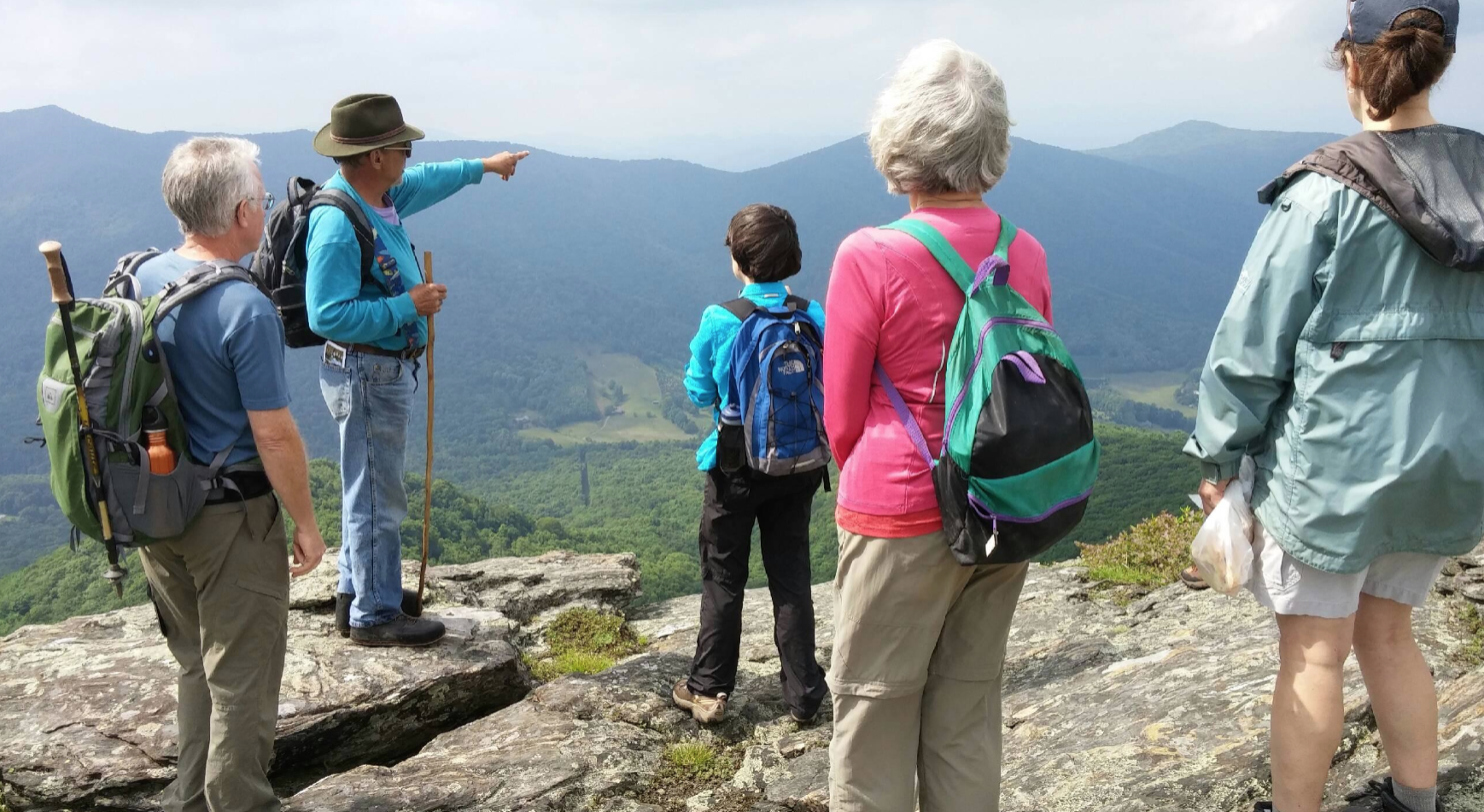
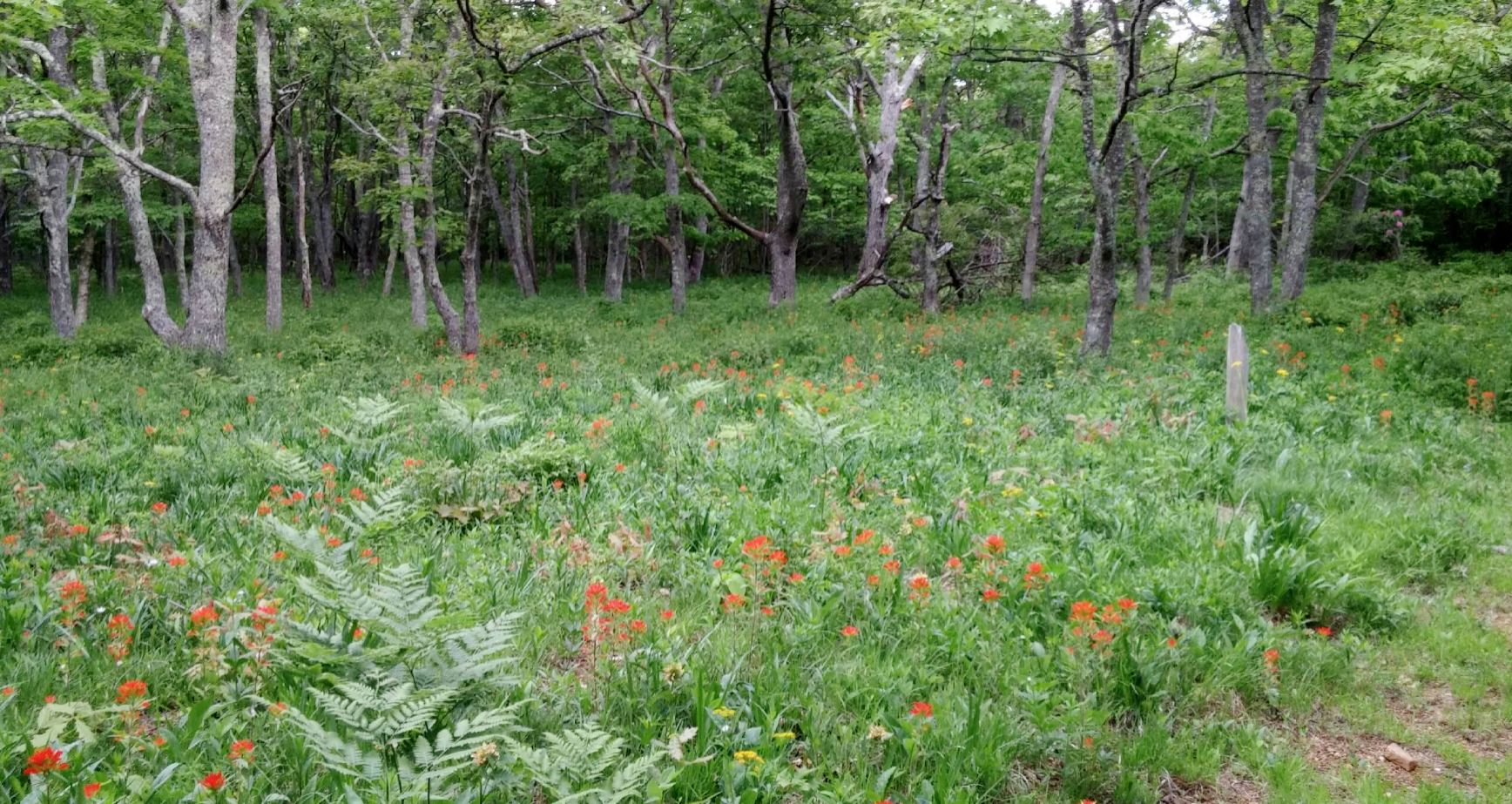
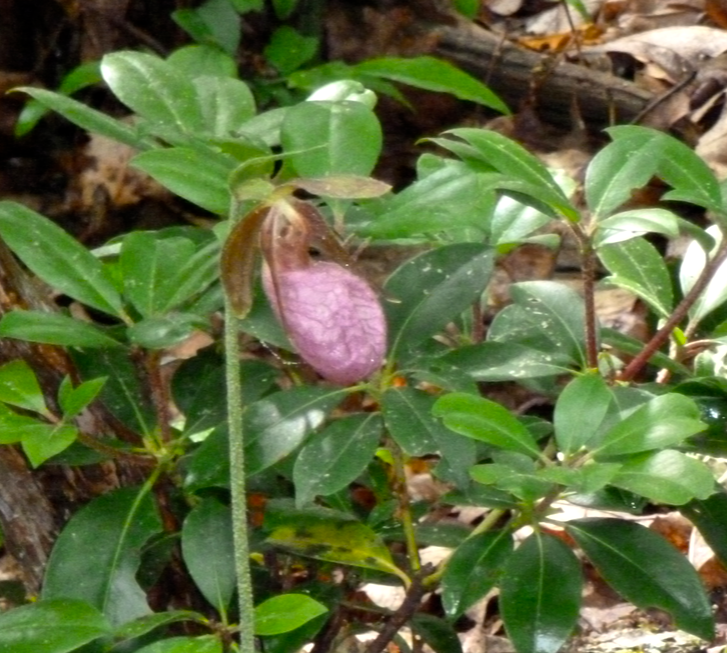
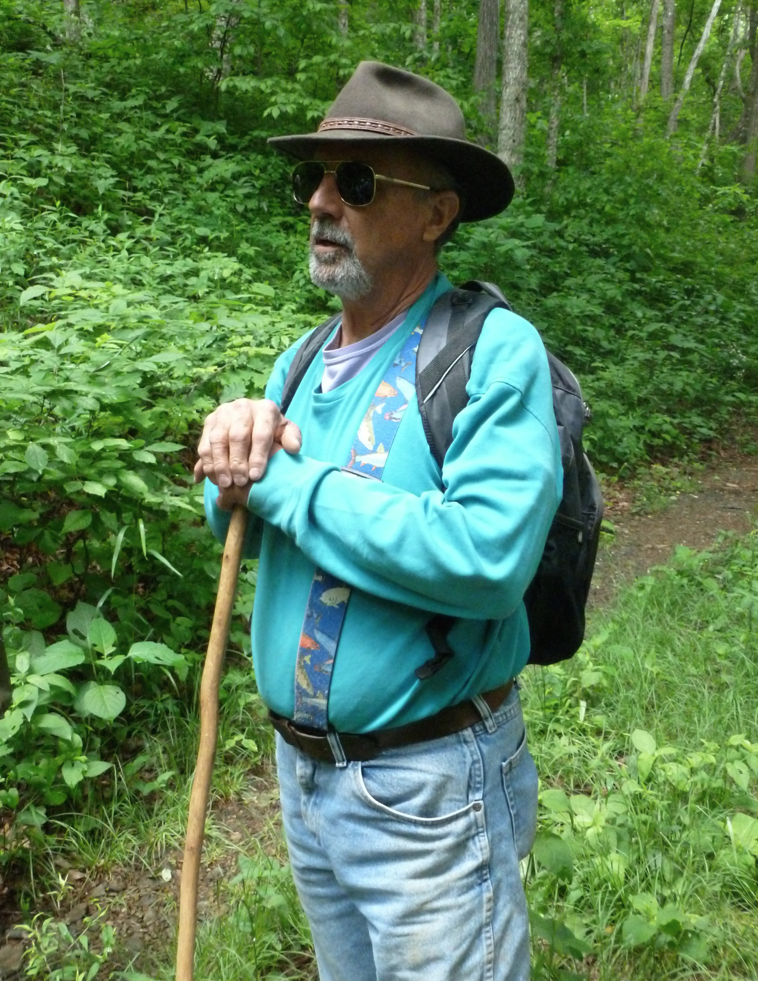
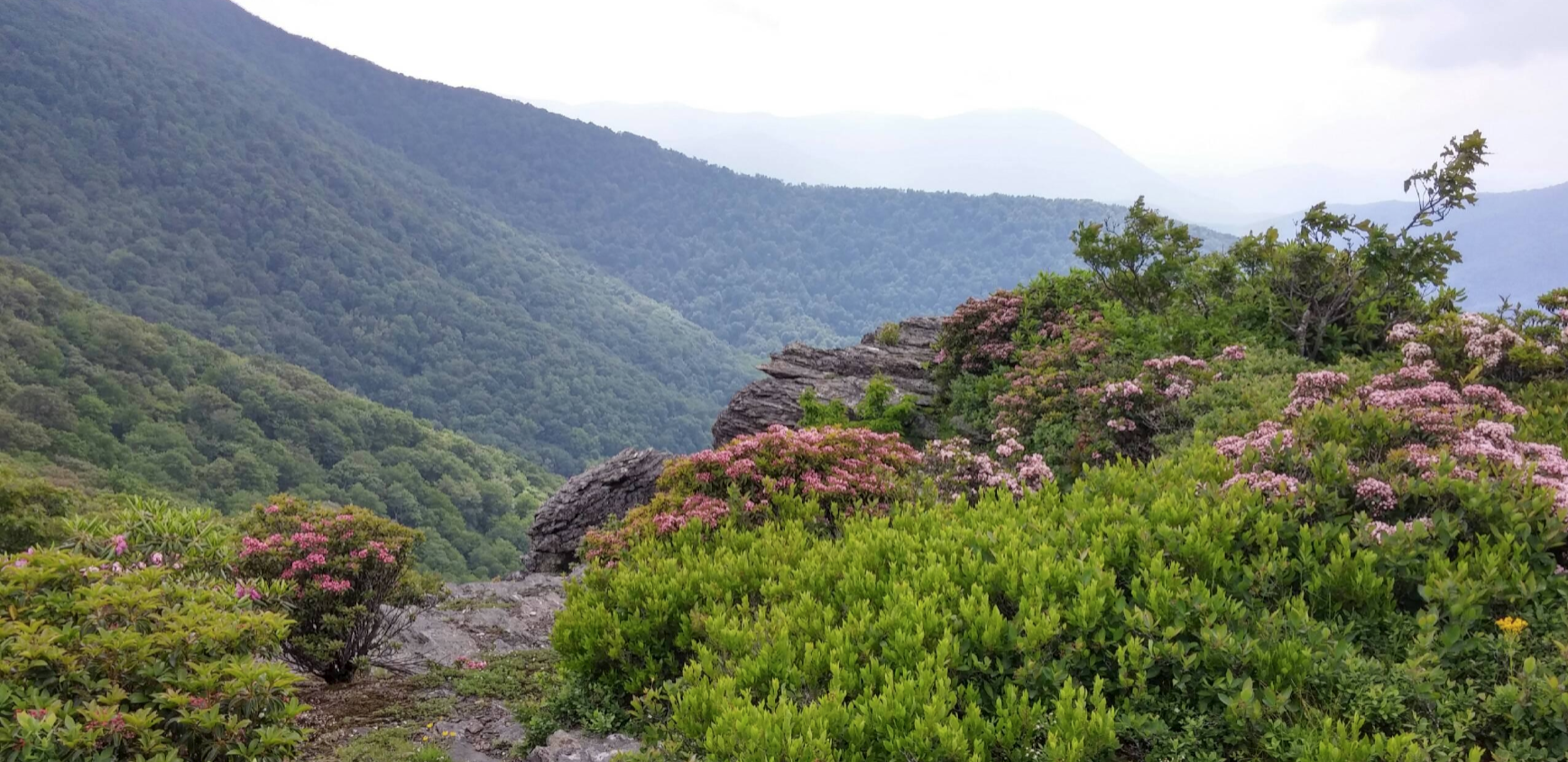
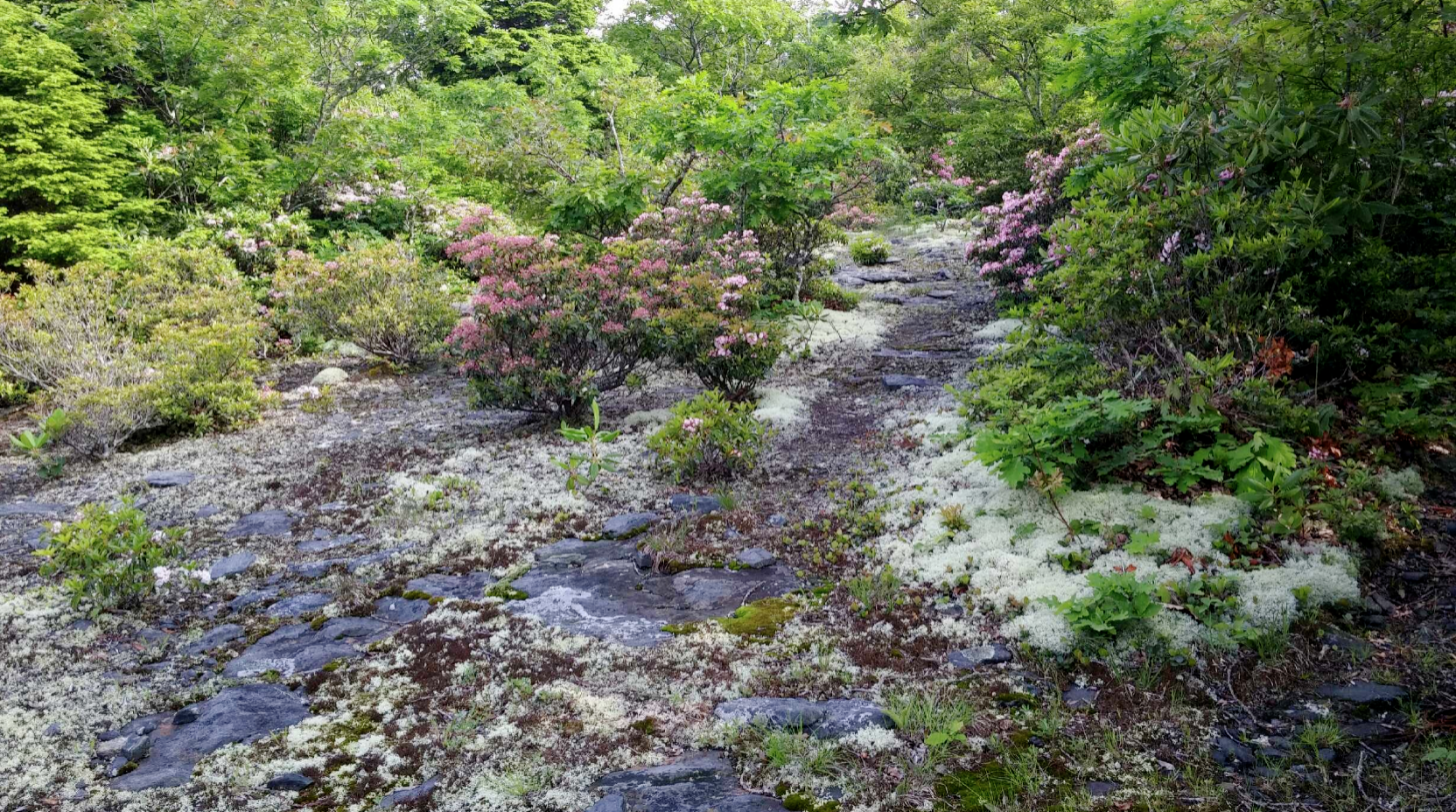

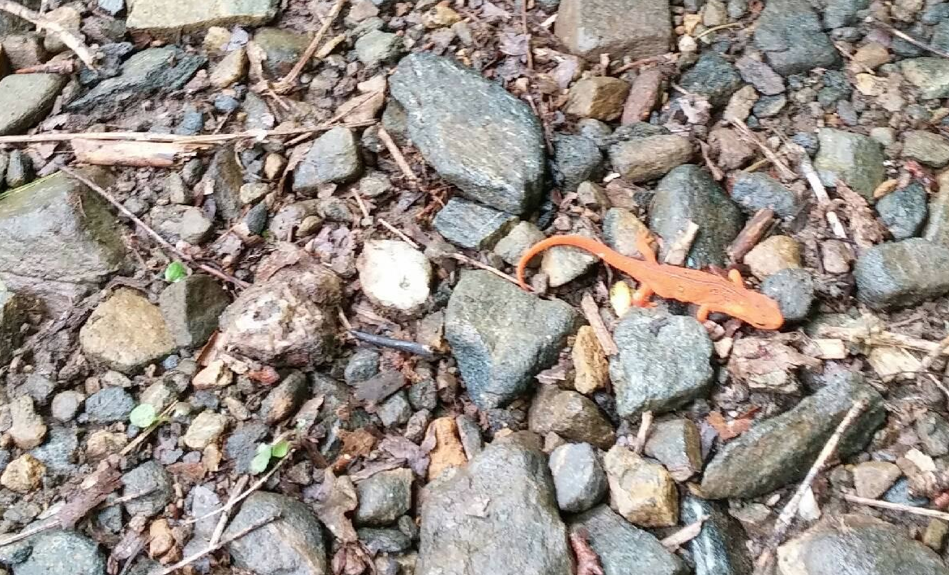

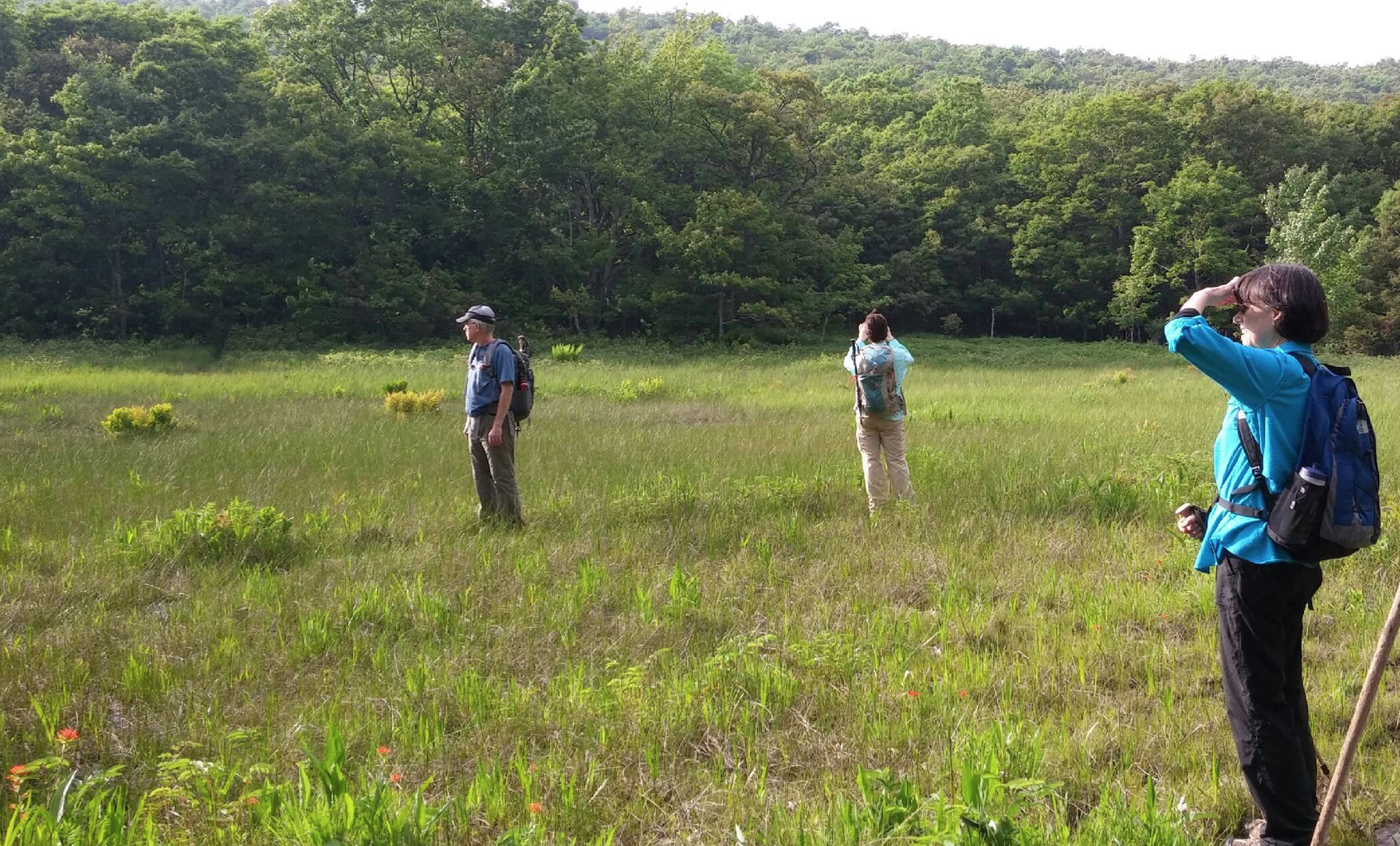
The Blue Ridge Expedition hike of The Nature Conservancy's Bluff Mountain Nature Preserve was smiled upon by the weather gods as the fog lifted as the hike began and the rain fell as the hike ended. Hikers were treated with peak blooms of mountain laurel at Perkins Rock and the mesic glade and indian paintbrush in the meadow. Numerous red efts shared the trail without a single casualty which was a minor miracle considering there were thirty feet finding their way.
Catawba rhododendron and pink lady slippers were about finished blooming but the sun dews in the fen were in their full minuscule revery.
Five of the hikers were board members of The Florence Thomas Art School along with the director of the school, Kathleen Janowiak. BRDC and The Florence Thomas Art School are discussing a collaboration of art and nature in the not to distant future as part of the Blue Ridge Illustrated program.
There are two more hikes on the calendar for the Bluff Mountain Nature Preserve with spaces available on August 2 and October 11, first come first serve.
Blue Ridge Expeditions: Turk Mountain
A crew of 16 people met for the day’s adventure on Turk Mountain in Augusta County, Virginia. Our journey was one of scales: geological, ecological and cultural. Our expedition began with some flexing of the imagination, 550 million years ago upon white sand beaches.
Time Travel on the Talus of Turk
On the morning of May 23, a crew of 16 people met for the day’s adventure on Turk Mountain in Augusta County, Virginia. Our journey was one of scales: geological, ecological and cultural. Our expedition began with some flexing of the imagination, 550 million years ago upon white sand beaches. Skolithos tube worms left their marks in the form of linear tube-shaped trace fossils. We moved forward through time watching mountains climb and fall and continents collide as our beach sands were crushed beneath the resulting weight and pressure – transforming them into the quartzite the gives us Turk Mountain today. We stood, 15,000 years ago, deep beneath the peri-glacial ice and snow and watched the freeze-thaw activity break the quartzite into massive blocks. They tumbled from the cliffs above and crept down the north face of the mountain. We watched the ice and cold depart northward, and the tundra, fir, spruce and northern hardwood forests with it. Those ancient ecosystems with all their cold climate plants and animals long ago found their home in up-state New York and Canada. But, they once were here in Virginia. In only a few special places, with cold and sheltered micro-climates, do we find vestiges for the few disjunct plant communities that remain behind. So is the case for the Paper Birch of Turk Mountain. We stood in a forest that was logged repeatedly over the past couple hundred years, and engulfed in a roaring fire less than 50 years ago. The scars in the forest tell that story, and a story of renewal as part of fire ecology. Lastly, we stood in the future, pondering the changes, or lack-thereof, upon this complex and varied Blue Ridge landscape.
Dry-mesic Oak-Hickory-Pine Heath forest
During the majority of the hike we passed through a dry-mesic pine-oak-hickory forest with a heath dominated understory. Written in this landscape is a logging operation and an intense fire. The multi-trunked and fire resistant chestnut oak trees spoke of the region’s appetite for iron-smelting. The demand on the forests for charcoal production was high, and no trees within reasonable reach were spared, not even those gnarled and stunted chestnut oaks on Turk mountain. Not too long ago a fire cleaned out the understory…possibly 30-40 years ago. Pignut hickory, scarlet oak, table mountain pine and pitch pine are prevalent in the canopy. American chestnut is ever present rising to as high as 25 feet from the acidic and rocky forest floor along with bear oak, downy serviceberry, red maple, minniebush, mountain laurel, pinxter azalea, mountain holly and witchhazel. Deerberry, bracken fern, and two blueberry species blanket the ground leaving very little room for sedges and herbaceous perennial flowering species. Spicebush swallowtail butterflies oviposit on sassafras seedlings and an eastern fence lizard darts through the dry leaves on the ground. Ovenbirds gave us song the entire way. We stopped in the trail at about 2,600 feet elevation and made haste, off trail, in the direction of 60 degrees west of north, up a steep slope, and around the “back side” of the mountain.
Low Elevation Boulderfield Forest (<3,200 ft. ele)
Eventually the ground began to move beneath our feet. The angle of slope increased and shifting quartzite talus became the dominant substrate. We transitioned gradually to an Appalachian boulderfield forest, consisting of black birch, paper birch (two small clusters), northern red oak, chestnut oak, striped maple, mountain maple, minniebush, Appalachian gooseberry, northern lowbush blueberry, marginal wood fern, American alumroot, Virginia creeper, very little else. Growing conditions are harsh at this site. There is very little opportunity for fine sediment accumulation and soil building processes. Access is difficult as well, and this likely resulted in the preservation of certain trees during the massive clear cutting that occurred during the 19th-20th centuries. The hypothesis must be tested, but I believe there are small pockets within this ecosystem that are “virgin forest” – that is, areas that have never been logged, cleared, burned, or otherwise affected by anthropogenic activities. The most longest lived flora may be the giant gnarled black birch trees reaching up from the ocean of quartzite boulders in the open canopy areas. Moving west the talus turned from small boulders to giant blocks. Ahead we could see the bright white slopes free of vascular growth.
Lichen / Bryophyte Nonvascular Boulderfields
Lichen-dominated boulderfields are scattered across the backside of the mountain in a great patchwork. In some cases bits of the forest reach into the boulder fields, following nutrient-rich sediment pockets. In other cases, the boulderfields completely engulf small patches of forest. The quartzite boulders offer very little in the way of nutrients for plants. The lichens that cover them find little competition, and thus they have diversified to fill every little niche. The following unique lichen species are indicators for this ancient non-vascular plant community: Cladonia furcata, Cladonia rangiferina, Cladonia uncialis, Melanelia culbersonii, Cladonia squamosa, Xanthoparmelia conspersa, Dimelaena oreina, Lasalia pensylvanica, Lasallia papilosa, Hypogymnia physodes, and Physcia subtilis. An occasional Appalachian rock polypody (Polypodium appalachianum) clings to the talus. Dragonflies, sawflies, millipedes, spiders and an occasional lady bug made their presence among the lichens, and though we did not encounter any, the potential of disturbing timber rattlesnakes kept us on alert.
Betula papyrifera vs. Betula cordifolia
After braving the steep slopes and shifting talus to reach our destination, we explored the ecology of the paper birch tree. Using a detailed dichotomous key, participants observed the attributes that make these trees unique. While the Mountain paper birch (Betula cordifolia) is well documented in the area (an ice-age relic species that likely diverged from the northern paper birch long ago, gifting the Blue Ridge with yet another unique species), our target tree, Paper birch (Betula papyrifera), has not been confirmed south of the Potomac River. We counted veins on leaves, observed the pubescent twigs, the cuneate to truncate leaf bases, the distinct bark, and other characteristics. Comparing these attributes sheds light on the differences between the trees. We departed, grateful to have the opportunity to visit these trees and to be gifted such a beautiful day. We ventured back through changing ecosystems, downslope, upward in temperature and forward in time. Back in Charlottesville we found ourselves in temperatures 10-12 degrees warmer than the north slopes of Turk Mountain - and 25 to 30 degrees warmer than the cold pockets of air at the base of the talus slope - among the cavernous blocks of quartzite that offer the disjunct paper birch trees a tiny refuge here in the Blue Ridge.
Ecosystem-based species observations from the hike:
Dry-mesic Oak-Hickory-Pine Heath forest
Acer pensylvanicum (striped maple)
Acer rubrum (red maple)
Betula lenta var. lenta (sweet birch)
Carex appalachica (Appalachian sedge)
Carya glabra (pignut hickory)
Carya species unid. (unid. Hickory)
Carya tomentosa (mockernut hickory)
Castanea dentata (American chestnut)
Coreopsis verticillata (thread-leaf coreopsis)
Dioscorea villosa (Wild yam)
Dryopteris marginalis (marginal wood fern)
Gillenia stipulata (American ipecac)
Hamamelis virginiana (witch hazel)
Hieracium venosum (Rattlesnake weed)
Houstonia longifolia (longleaf bluet)
Hypoxis hirsuta (Yellow star grass)
Ilex Montana (mountain holly)
Iris cristata (dwarf crested iris)
Kalmia latifolia (mountain laurel)
Maianthemum racemosum (False Solomon’s seal)
Menziesia pilosa (minniebush)
Papilio troilus (spicebush swallowtail butterfly)
Parthenocissus quinquefolia (Virginia creeper)
Pinus pungens (table mountain pine)
Pinus rigida (pitch pine)
Polygonatum biflorum (Solomon’s seal)
Potentilla Canadensis (dwarf cinquefoil)
Pteridium aquilinum (bracken fern)
Quercus coccinea (scarlet oak)
Quercus ilicifolia (bear oak)
Quercus falcata (black oak)
Quercus montana (chestnut oak)
Quercus rubra (northern red oak)Rhododendron periclymenoides (pinxter azalea)
Rubus flagellaris (Common dewberry)
Sassafras albidum (sassafras)
Sceloporus undulatus (eastern fence lizard)
Seiurus aurocapilla (ovenbird)
Taenidia integerrima (Yellow pimpernel)
Uvularia perfoliata (Perfoliate bellwort)
Vaccinium angustifolium (northern lowbush blueberry)
Vaccinium pallidum (hillside blueberry)
Vaccinium stamineum (Deerberry)
Viola pedata (Birdsfoot violet)
Zizia aurea (golden zizia)
Low Elevation Boulderfield Forest
Acer pensylvanicum (striped maple)
Acer rubrum (red maple)
Acer spicatum (mountain maple)
Amelanchier arborea (downy serviceberry)
Betula lenta var. lenta (sweet birch)
Betula papyrifera var. papyrifera (paper birch)
Diervilla lonicera (northern bush-honeysuckle)
Dryopteris marginalis (marginal wood fern)
Hamamelis virginiana (witch hazel)
Heuchera americana var.hispida (American alumroot)
Ilex Montana (mountain holly)
Menziesia pilosa (minniebush)
Parthenocissus quinquefolia (Virginia creeper)
Polypodium appalachianum (Appalachian rock polypody)
Quercus Montana (chestnut oak)
Quercus rubra (northern red oak)
Ribes rotundifolium (Appalachian gooseberry)
Vaccinium angustifolium (northern lowbush blueberry)
Vireo olivaceus (red-eyed vireo)
Narceus americanus (American giant millipede)
(Unidentified spider)
Lichen / Bryophyte Nonvascular Boulderfields
Cladonia furcata (cup lichen)
Cladonia rangiferina (gray-green reindeer lichen)
Cladonia squamosa (cup lichen)
Cladonia uncialis (cup lichen)
Dimelaena oreina (golden moonglow)
Hypogymnia physodes (tube lichen)
Lasallia pensylvanica (Pennsylvania toadskin lichen)
Lasallia papulosa (blistered naval lichen)
Melanelia culbersonii (Culberson's black-parmelia)
Physcia subtilis (rosette lichen)
Polypodium appalachianum (Appalachian rock polypody)
Xanthoparmelia conspersa (peppered rock-shield)
(Unidentified dragonfly)
Coccinella septempunctata (seven spotted ladybug)
(Unidentified spider)
Resources:
Gallery of Photographs from this hike: https://goo.gl/photos/ESBYNLvkr6owhppz6
Exploring the Talus of Turk: Discovery of a Possible New Virginia Tree: http://blueridgediscoverycenter.org/blueridgediscoverycenterblog/2011/07/exploring-talus-of-turk.html
Natural Plant Communities of Virginia: http://www.dcr.virginia.gov/natural_heritage/natural_communities/ncoverview.shtml
Paleogeographical Maps of North America: https://www2.nau.edu/rcb7/nam.html
Digital Atlas of Virginia Flora: http://vaplantatlas.org
Kids Farm Day at Matthews Living History Farm Museum
Kids Farm Day
May 15th, 2015
“Mr. Scott, would we be doing this 100 year ago?”
“No”, I replied. “We would not have had that kind of time. But I like your question.”
The purpose of this annual event is to acquaint first graders from Grayson and Galax to the conceptual perspective that time and our place in it changes along with technology and how we adapt. David Hauslohner, the man behind the idea and president of the farm museum, explains to each busload of these kids, that 100 years ago, our lives would be so different to be hardly recognizable. Yet he champions the settlers’ abilities to educate themselves in all the arts and skills required to live an isolated life, from animal husbandry, plowing (behind a mule or ox), to tool making and creating their own clothing from fiber harvested from the livestock and plants. He further points out the fact that today’s educational regimen requires us to specialize, creating for many of us an uncomfortable distance between what is essential but hidden, and limits our understanding of where food comes from and where our connections between land and life are being compromised.
The day is arranged in 20 minute segments, with a variety of stations set out and around the farm…including an opportunity for the kids to see real live cows, horses, and pigs; experience historic yet live music along with some story-telling, black-smithing, gardening and insect identification.
BRDC’s contribution is based on instructing the kids in the value of pollinators. Our current agribusiness broad sweeping pesticide approach to controlling insect pests also impacts pollinators and other beneficial insects and arthropods, which did not happen 100 years ago. Simplistically, BRDC’s role is to explain that there are both ‘good bugs’ as well as ‘bad bugs’, and that we need to inform ourselves about this difference. Pollinators seemed to be the best example and approach.
So like last year, after an introductory chat about the value of pollinators and their role in agriculture, we headed out to the field with insect nets, viewing boxes, and ear-splitting enthusiasm. We were able to capture and identify small bees, flower beetles and other less farmer friendly insects such as grasshoppers and weevils. Enough variety including small spiders were present to give the kids an idea of what small animals co-exist with all that happens on a farm.
“Why would we not have the time?”, asks the inquisitive youngster. “Because in those days and by your age, you would be busy milking the cows, slopping the pigs, hoeing the garden or mending a fence. Not running around with a net looking for bugs. That would be considered silly and wasteful behavior.” Though, I thought to myself, there were certainly exceptions.
A beautiful day at Hungry Mother State Park Birding Adventure Weekend!
BRDC set up shop at Hungry Mother State Park this past weekend where we shared our traveling booth of wonders with visitors. Area youth dissected owl pellets and studied raptor wings, skulls and talons. While tending our booth we got to scope birds on the lake including, pied-billed grebe, red-breasted mergansers and eastern kingbirds.
BRDC set up shop at Hungry Mother State Park this past weekend for their Birding Adventure Weekend, where we shared our traveling booth of wonders with visitors. Area youth dissected owl pellets and studied our collection of raptor wings, skulls and talons. While tending our booth we got to scope birds on the lake including, pied-billed grebe, red-breasted mergansers and eastern kingbirds.
BRDC Discovery prompts study of Virginia Paper Birch
Way back in 2011 one our guides, Devin Floyd, took a group of young explorers up into a very unique habitat on Turk mountain in search of rare species. They were searching in a north facing rock talus for ice age relic species. Low and behold that group found and documented a tree that had characteristics fully matching a Paper Birch, Betula papyrifera. The Paper Birch is a species that isn't usually documented as living south of Pennsylvania.
Way back in 2011 one our guides, Devin Floyd, took a group of young explorers up into a very unique habitat on Turk mountain in search of rare species. Their goal was to scour a north facing rock talus for ice age relics. Low and behold they found and documented a tree that had characteristics fully matching a Paper Birch, Betula papyrifera. The Paper Birch is a species that is rarely south of Pennsylvania!
Since then A Study of Virginia Paper Birch has gotten underway, organized by the Virginia Natural Heritage Program and Chip Morgan. Genetic sequencing will be used to figure out the identity of the tree and determine the degree of variation among Virginia birch populations.
The full blog post about the exploration can be seen here: Exploring the Talus of Turk
Galax Elementary Winter Enrichment Week
After nearly a month of planning, BRDC along with other community organizations, teachers and the Galax City Public Schools’ administration office, came together to offer elementary and middle school students a wide array of educational options and opportunities. BRDC’s role focused on four programs: National Fishing in Schools, led by Aaron Floyd and Lisa Benish with assistance from Roald Kirby and Mike Floyd; Reading the Blue Ridge, led by Sarah Osborne and Brenda Bonk with assistance from Scott Jackson-Ricketts and teacher’s aid, Theresa Mawyer; Microscope Fun, co-led by Evan Worrell, Scott, Brenda and with assistance from Lauren Peery, William Roberts and Roald; and Blue Ridge Expeditions trip to Grandfather Mountain, led by William and Joyce Roberts. All of BRDC’s programs were held in the elementary school.
Galax Intercession Week: Guides and program directors from BRDC committed the entire week of February 9th through the 13th to a variety of programs designed to fit both the remedial and enrichment categories built into intercession week requirements.
After nearly a month of planning, BRDC along with other community organizations, teachers and the Galax City Public Schools’ administration office, came together to offer elementary and middle school students a wide array of educational options and opportunities. BRDC’s role focused on four programs: National Fishing in Schools, led by Aaron Floyd and Lisa Benish with assistance from Roald Kirby and Mike Floyd; Reading the Blue Ridge, led by Sarah Osborne and Brenda Bonk with assistance from Scott Jackson-Ricketts and teacher’s aid, Theresa Mawyer; Microscope Fun, co-led by Evan Worrell, Scott, Brenda and with assistance from Lauren Peery, William Roberts and Roald; and Blue Ridge Expeditions trip to Grandfather Mountain, led by William and Joyce Roberts. All of BRDC’s programs were held in the elementary school.
Field trip to Grandfather: On Tuesday, William and Joyce Roberts chaperoned a bus-load of middle school students on a BRDC sponsored field trip to Grandfather Mountain. In spite of the wind and bone chilling cold, the trip was a success, and we are grateful to the staff at Grandfather and William and Joyce for pulling this off.
National Fishing in the Schools Program: Aaron Floyd and Lisa Benish led five days of fly fishing lessons. The kids learned about equipment, casting technique, journaling, fly tying and fish species. A full description of this program is located here: Blog text for NFSP in Galax
Reading the Blue Ridge: Sarah Osborne explored the Blue Ridge through literature, reading with a group of kids about a wide variety of subjects .
Microscope Fun: Aside from the art component already discussed, each day had its own theme. We started out with leaf litter and soil critters, digging out specimens to be observed through the scopes. After a break and further instructions on microscope use, the kids got to view stream macro-invertebrates netted from a tank provided by BRDC.
Day two began with a discussion on trees: leaves, twigs, and nuts, while describing the variety of ecosystems different trees help create, including animal associations such as food and shelter. BRDC shared boxes of leaves, seeds and twigs for the kids to examine and use for sketching models.
Wednesday was devoted to birds and bird parts. Along with feathers, feet, and skulls we offered several very different bird nests and talked about the materials birds use to build their amazing nests. Feathers were views through the microscopes, and clay was used to model skulls and other bird bones. William read a book, Roald played the role of an old mountain man whom William interviewed on avian facts, and for the last hour, owl pellets were brought out for the kids to dissect.
On Thursday, we reviewed the week, worked on our art and prepared for the field trip to CCSA on Friday. The kids were asked to pick artifacts through touch only, like a grab bag, and then sketched what they had in hand.
Emphasis for both our reading and microscope programs revolved around the combination of hands on activities and art. Only Wednesday proved warm enough for area based field trips, but both the fishing and reading programs were able to get their classes outdoors…barely and bravely. BRDC partnered with Chestnut Creek School of the Arts for two Friday field trips based on the art work we had the kids make. CCSA rolled out the red carpet for our little guests (K-1), with a full tour of the facilities populated by some of the older kids who participated in intercession week at the various classrooms and workshops provided by CCSA.
BRDC wishes to thank the following for their commitment to making this week a success:
Brenda Bonk, Lisa Benish, William and Joyce Roberts, Lauren Peery, Roald Kirby, the school staff, and central office personnel.
Hokie Bugfest!!
Clyde Kessler and Scott Jackson-Ricketts set up a BRDC booth at the 4th annual Hokie Bugfest. This year's Hokie BugFest (HBF) attendance was 6,112 - a significant increase over 4,229 of last year.
Photo Credit: WDBJ7 News
Clyde Kessler and Scott Jackson-Ricketts set up a BRDC booth at the 4th annual Hokie Bugfest. This year's Hokie BugFest (HBF) attendance was 6,112 - a significant increase over 4,229 of last year.
Our set-up consisted of a selection of insect and spider field guides, drawing pads and colored pencils, encouraging the kids to draw their favorite bug. Then Scott pressed the sketch into a button for the kids to take home. Over 200 buttons were made at the BRDC table.
Blue Ridge Expeditions: Brushy Mountain Hike, Bland County, VA
Finally, some fun in the sun! On September 27th, after two previous hikes in the rain, seven of us had a wonderful sunny day on the trail. With perfect temperatures, we traversed the spine of Brushy Mountain in the Crandon area of Bland, VA. Starting at Route #608, we hiked the 5.3 miles to Route #606 at a 150 foot long suspension bridge over Kimberling Creek. Participants came from Bland, Wythe, and Mercer counties.
Blue Ridge Expeditions: Brushy Mountain Hike, Bland County, VA
Finally, some fun in the sun! On September 27th, after two previous hikes in the rain, seven of us had a wonderful sunny day on the trail. With perfect temperatures, we traversed the spine of Brushy Mountain in the Crandon area of Bland, VA. Starting at Route #608, we hiked the 5.3 miles to Route #606 at a 150 foot long suspension bridge over Kimberling Creek. Participants came from Bland, Wythe, and Mercer counties.
No bear, deer, or turkey, but we did see an unusual millipede and some beautiful ferns and fungus. We heard raven, white-breasted nuthatch, and downy woodpeckers.
Mushroom Walk at River Ridge Farm
Last Saturday's mushroom walk at River Ridge Farm was a great success! The weather was just perfect we had at least 16 participants. There was a lot of interest and excitement and the fungi were out in force. With the time we had; it was not possible to prepare a comprehensive species list. However, just in a quick run through I was able to ID 56 species from the walk. Not bad for a morning stroll through the forest!
Last Saturday's mushroom walk at River Ridge Farm was a great success! The weather was just perfect we had at least 16 participants. There was a lot of interest and excitement and the fungi were out in force. With the time we had; it was not possible to prepare a comprehensive species list. However, just in a quick run through I was able to ID 56 species from the walk. Not bad for a morning stroll through the forest!
Photo Credit: Joan Sunday
We started out the day, while everyone was arriving, by reviewing a selection of several species that I had previously collected and brought for demonstration. This gave everyone a chance to meet one another and familiarize themselves with a bit of the language of mycology. This turned out to be very helpful once we started collecting during our walk. There was at least some familiarity with how to look at fungi and some of the terminology.
Here are a few highlights and notable finds: We did come across 3 different species of Amanitas, which made it possible to familiarize everyone with the characteristics the make up this genus.This is very important since some species of amanitas can be deadly poisonous!
We ran across a dozen species of Boletes; including the beautiful "Two Colored Bolete" B. bicolor and the blue staining Gyroporus cyanescens which stains dark blue immediately when it is handled.
There were 3 species of the highly sought after chanterelles; ie, the "Cinnabar Chanterelle"Cantherellus cinnabarinus, the "Horn of Plenty"Craterellus cornucopoides, and the "Golden Chanterelle"C. cibarius.
Other notable finds among the gilled mushrooms were many species of Russulas of many colors and Lactarius species that exude a type of "milk"when injured. There were several species of the colorful Entolomas, including the "Yellow Unicorn"E. murrayii and the "Salmon Witch's Hat"E salmoneum. We looked at many types of Polypores or "shelf fungi" such as the medicinal "Turkey Tails"Trametes versicolor and the "Cinnamon Polypore"Coltricia cinnamomea. An exciting find; growing from the base of a dead tree was Meripilus gigantea, which can grow to the size of several pounds. Higher up on the same tree were 2 specimens of the "Bearded Tooth"Hericium erinaeus, another highly regarded edible. Unfortunately,all we could do was look at them since they were way out of reach.
We were able to compare the edible and common "Gem-studded Puffball"Lycoperdon perlatum with the "Poison Pigskin" Puffball Schleroderma citrinum. Also, there were several different colorful species of the coral mushrooms including the "Golden Tuning Fork"Clavulinopsis fusiformis. One of the most exciting finds for me was a species of "Cup Fungus"called "Moose Antlers"or Wynnea americana. This is a very unusual looking fungus and fairly rare in our area.
We ended the day by going over to the picnic area and displaying our finds and having a discussion of each type; including toxicity/edibility, etc followed by a great picnic lunch and more mushroom talk. I believe a good time was had by all and a lot was learned and shared. There were several requests for a repeat sometime in the future.
- Ken Crouse
Mushroom Species List
River Ridge Farm
9/20/2014
Gilled mushrooms:
Amanita vaginata – Grisette
A. flavaconia – Yellow Patches
A. ceceliae
Russula virescens – Green Russula
R. variata – Variable Russula
R. compacta – Firm Russula
R. rosacea – Rosy Russula
R. aeruginea – Green Quilt Russula
R. brevipes – Shortstalked White Russula
Lactarius croceus
L. peckii – Peck's Milky
L. rufus – Redhot Milky
L. torminosus – Pinkfringed Milky
L. subpurpurea – Variegated Milky
Tricholoma sp.
Gymnopus dryophila – Oak Loving Collybia
Clitocybe clavipes – Clubshaped Clitocybe
Clitocybe gibba – Funnel Clitocybe
Hygrophoropsis aurantiacaFalse Chanterelle
Hygrocybe coccinea Red Waxycap
Cantharellus cinnibarenis—Cinnabar Chanterelle
Cantharellus tubaeformis –Trumpet Chanterelle
Cantharellus cibarius Golden Chanterelle
Craterellus cornucopioides – Horn of Plenty
Nolanea murrayii – Yellow Unicorn
Nolanea salmoneum Salmon Unicorn
Marasmius siccus – Orange Pinwheel
Marasmius rotula – Pinwheel Marasmius
Marasmius nigripes Black Foot
Poroid Fungi:
Boletus bicolor – Twocolored Bolete
B. subvelutipes – Redmouthed Bolete
B. chrysenteron – Cracked Cap Bolete
B. ornatipes – Ornatestalked Bolete
B. griseus
B. subglapripes
Gyroporous cyanescens Bluing Bolete
Leccinus scabrum – Scaber Stalk
Suillus granulatus – Granularstalked Suillus
Strobilomyces floccopus – Old Man of the Woods
Tylopilus felleus – Bitter Bolete
T. plumboviolaceus Lilacbrown Bolete
Polypores/Shelf Fungi
Meripilus gigantea – Blackstaining Polypore
Hericium erineus – Bearded Tooth
Trametes versicolor Turkeytails
Stereum ostrya – False Turkeytails
Polyporus badius – Blackfooted Polypore
Coltricia cinnamomea—Shiny Cinnamon Polypore
Puffballs'Earthballs:
Lycoperdon perlatum – Gemstudded Puffball
Schleroderma citrinum – Poison Pigskin Puffball
Coral/Club Fungi:
Clavaridelphus truncaFlattopped Coral
Cordyceps militaris Trooping Cordyceps
Clavulinopsis fusiformis Spindleshaped Yellow Coral
Tremellodendron pallidum White Jellycoral
Ramariopsis kunzeii – White Coral
Cup Fungi:
Wynnea americana Moose Antlers
Peziza badioconfusa –Common Brown Cup
Peziza repanda – Recurved Cup
Parasitic Molds:
Hypmyces hyalinus – Amanita Mold
Hypomyces chrysospermus White Bolete Mold
